From hydrocarbons to new energies Egypt forges ahead
Oil market outlook
Global upstream: what to look out for


Digital transformation in energy and utilities
Taking the lead in climate technologies
Gas detection solutions
Advanced connectivity for oil and gas

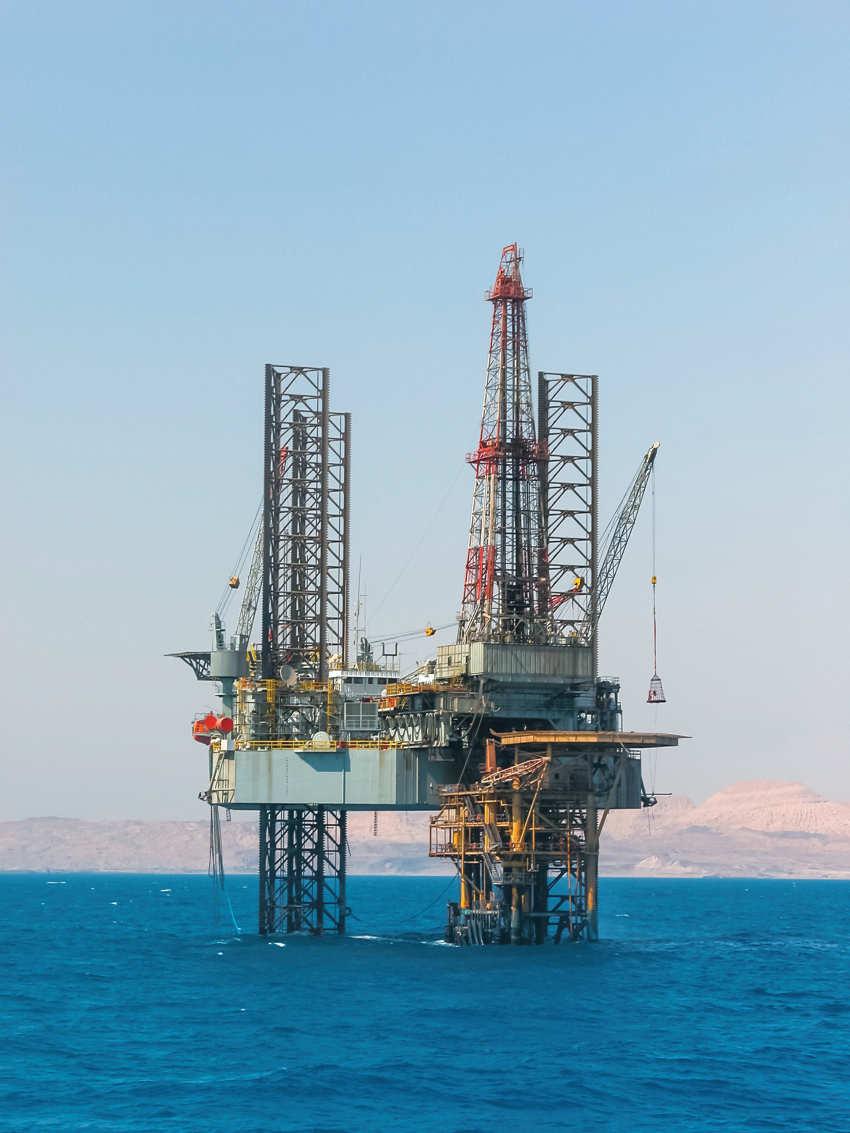
VOLUME 26 | ISSUE 1 2023 www.oilreview.me
the regional oil & gas sector since
26
Serving
1997
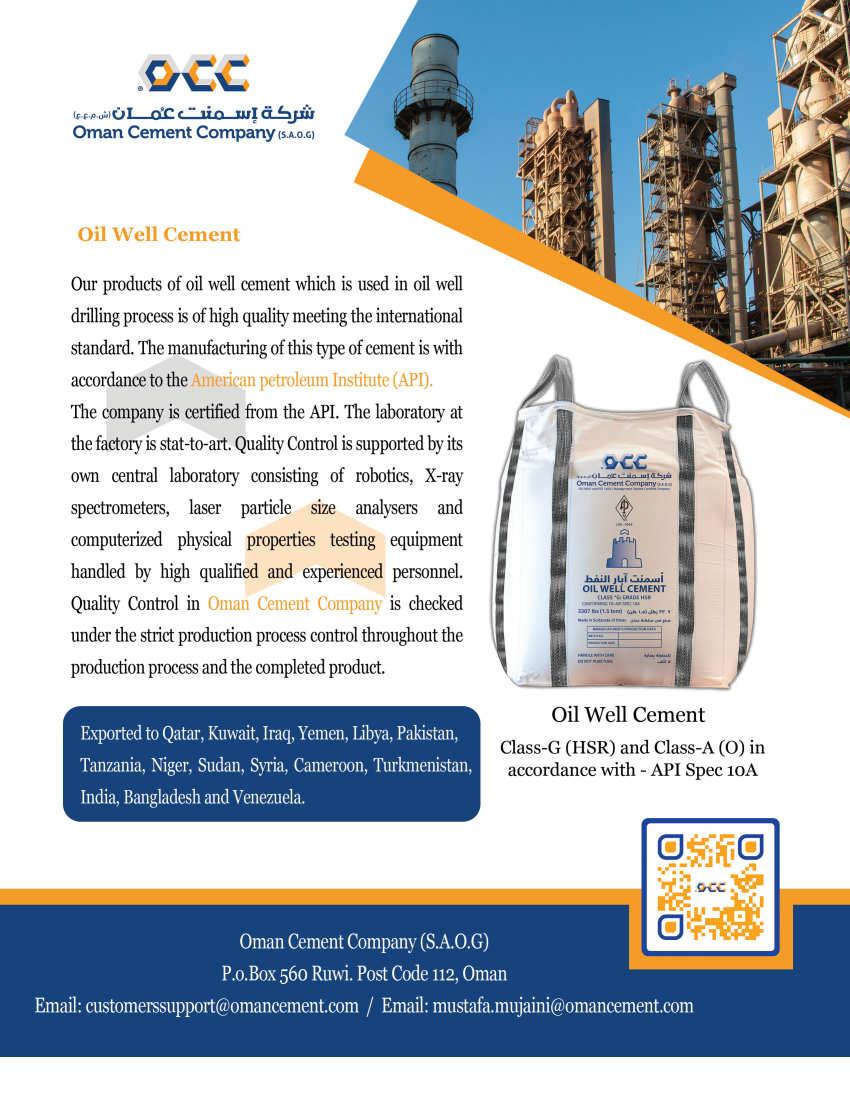
Serving the world of business
Editor: Louise Waters - louise.waters@alaincharles.com
Editorial and Design team: Prashanth AP, Fyna Ashwath, Miriam Brtkova, Praveen CP, Robert Daniels, Shivani Dhruv, Matthew Hayhoe, Leah Kelly, Rahul Puthenveedu, Madhuri Ramesh, Madhurima Sengupta and Minhaj Zia
Publisher: Nick Fordham
Sales Manager: Vinay Nair
vinay.nair@alaincharles.com
Magazine Sales Manager: Tanmay Mishra
+91 98800 75908
tanmay.mishra@alaincharles.com
International Representatives
Nigeria Bola Olowo
+234 8034349299
bola.olowo@alaincharles.com
USA Michael Tomashefsky
+1 203 226 2882 +1 203 226 7447
michael.tomashefsky@alaincharles.com
Head Office:
Alain Charles Publishing Ltd University House, 11-13 Lower Grosvenor Place, London, SW1W 0EX, United Kingdom
+44 (0) 20 7834 7676 +44 (0) 20 7973 0076
Middle East Regional Office:
Alain Charles Middle East FZ-LLC Office L2-112, Loft Office 2, Entrance B, P.O. Box 502207, Dubai Media City, UAE
+971 4 448 9260, +971 4 448 9261
Production: Rinta Denil, Ranjith Ekambaram
Eugenia Nelly Mendes and Infant Prakash
production@alaincharles.com
Subscriptions: circulation@alaincharles.com
Chairman: Derek Fordham
Printed by: Buxton Press
Printed in: January 2023
© Oil Review Middle East ISSN: 1464-9314
Editor’s note
EGYPT’S GAS ECONOMY has roared back to life in the past few years – but the country is looking beyond hydrocarbons too, especially after hosting COP27 in November 2022, when several agreements were signed to develop green hydrogen and ammonia projects. Could Egypt be the next regional hydrogen hub? See our article on p18.
Already there have been several encouraging developments in the Middle East this year progressing decarbonisation and energy transition initiatives, as the UAE gears up to host COP28 in November. GCC countries could leverage their expertise as global leaders in oil and gas to develop other capital-intensive and geologically complex green energies (p27). Also in this issue we look at prospects for the oil market this year (p14) as well as key themes to watch out for in the upstream sector (p29). Turning to technology developments, we examine the state of digital transformation in energy and utilities (p33), the latest solutions for gas detection (p20) and the benefits of 5G for oil and gas operations (p34).
Contents
Calendar
4 Executives’ calendar
Listings of regional and international events, and previews of EGYPS and MEOS/GEO
News
8 Developments
A round-up of news from across the region, including ADNOC’s world-first fully sequestered CO2 injection project and the launch of a new Aramco subsidiary
Oil Market
14 Factors shaping the future of crude oil
Prospects for the oil market in 2023, with an examination of bullish and bearish signals
Egypt
18 From hydrocarbons to hydrogen
Despite Egypt’s gas sector roaring back to life in recent years, it is other innovative niches that may offer the greater potential long-term
Gas Detection
20 The latest solutions for gas detection
Gas leaks pose dangers to workers as well as to assets. As such, gas detection solutions could not be more imperative
Marine Services
24 SAFEEN Group
expansion
set for regional
Friedrich Portner, chief commercial officer, AD Ports Group, discusses growth prospects for SAFEEN Group and the company’s drive for optimisation
Decarbonisation
28 Tackling climate change with new technologies
The potential for the Middle East to assume a leadership role in climate technologies
Digitalisation
33 The state of digital transformation in energy and utilities
Findings of the IFS survey on the state of transformation in the energy and utilities sectors
Communications
34 Advanced connectivity for oil and gas
The benefits of 5G for oil and gas companies
Well Intervention
36 The time for well intervention
Prospects for the Middle East’s well intervention market are looking positive, according to a new report from Offshore Network
Wearable Technology
41 Optimising lubricants operations with wearable technology
How Shell’s Lube Advisor is enabling its customers to optimise their operations
Arabic
4 Analysis
Front cover image: Adobe Stock
Arabic front cover image: Aramco
www.oilreview.me email: orme@alaincharles.com
Issue 1 2023 oilreview.me 3
Executives’ Calendar, 2023
North Africa and the Mediterranean: supporting sustainable global energy supply and demand
EGYPS 2023 WILL take place from 13-15 February 2023 at the Egypt International Exhibition Center in Cairo. Held under the patronage and attendance of His Excellency Abdel Fattah El Sisi, President of the Arab Republic of Egypt, the Egypt Petroleum Show (EGYPS) will unlock opportunities across the full spectrum of the North African and East Mediterranean oil, gas and energy sector.
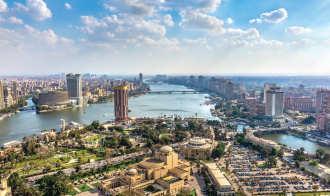
EGYPS is North Africa and the Mediterranean’s largest oil and gas exhibition and conference, where oil and gas professionals convene to engage in dialogue, create partnerships, do business and identify solutions and strategies that will reshape the global energy markets. Visitors will be able to identify opportunities from Egypt, North Africa and the East Mediterranean’s future project requirements and strategic priorities, while gaining insights into the wider oil and gas sector.
Set to attract 32,000 energy professionals from across the globe, EGYPS provides its visitors a unique platform for interaction between NOCs, IOCs, IECs and service providers, where leading energy companies from around the world will showcase the latest technologies and solutions. The event will feature more than 500 exhibitors and 15 international pavilions. Leading participants include Apache, Aspenteh, Axens, Baker Hughes, Bechtel, bp, Capricorn, HCH, Cheiron, Chevron, Dragon Oil, Echem, EGAS, EGPC, Energean, Enppi, Ganope, Halliburton, Hellenic Petroleum, Hellenic Energy, Huawei, IPR Energy Group, Kuwait Energy, Mubadala Energy, NESR, New Med Energy, NOV, Petrojet, Petronas, Saipem, SLB, Schneider Electric, Techip Energies, TransGlobe Energy, Wintershall Dea and Worley.
The exhibition features the Digitalisation in Energy Zone, for start-up businesses, SME’s and global technology companies to demonstrate and share their digital solutions and services shaping operations and driving transformative change across the oil, gas and energy industry.
EGYPS 2023 Conferences are an important enabler of engagement from government and policy level to industry leaders and influencers and engineers, providing technical enrichment. EGYPS drives the conversations
that address sustainable climate-conscious production of oil and gas as well as the growing commitment to energy transition and a net-zero future. They include the Strategic Conference, Technical Conference, Finance & Investment in Energy Conference, Sustainability in Energy Conference & Awards, and Equality in Energy Conference & Awards.
Energy Talks will reflect on the growing need for strategies in Decarbonisation, Hydrogen & CNG.
“EGYPS comes at a really crucial time for Egypt, for Africa and for the world, both for energy and climate,” commented Fatih Birol, executive director IEA.
Chris Bevan, country director Worley, said, “EGYPS helped us have more meetings over three days compared to six months under normal circumstances.”
For further information see the website at www.egyps.com
Calendar 2023
4 oilreview.me Issue 1 2023 Image Credit : Adobe Stock
EGYPS will take place in Cairo.
FEBRUARY 13-15 EGYPS CAIRO www.egyps.com 13-15 GDA Int’l Downstream Conference & Exhibition MANAMA www.gdaconference.org 19-21 MEOS GEO MANAMA www.meos-geo.com 28-2 March International Energy Week LONDON www.ieweek.co.uk MARCH 1-3 Int’l Petroleum Technology Conference (IPTC) BANGKOK https://2023.iptcnet.org 7-9 Middle East Energy DUBAI www.middleeast-energy.com 7-9 SPE/IADC Int’l Drilling Conference & Exhibition STAVANGER www.drillingconference.org 16-19 Basra Oil & Gas Exhibition BASRA www.basraoilandgas.com MAY 1-4 Offshore Technology Conference HOUSTON 2023.otcnet.org 16-18 May ME-TECH DUBAI https://europetro.com/metech 23-25 OMC Med Energy Conference & Exhibition RAVENNA www.omc.it.en SEPTEMBER 5-8 Gastech SINGAPORE www.gastechevent.com 5-8 Offshore Europe ABERDEEN www.offshore-europe.com Readers should verify dates and
information is sometimes subject to change.
location with sponsoring organisations, as this
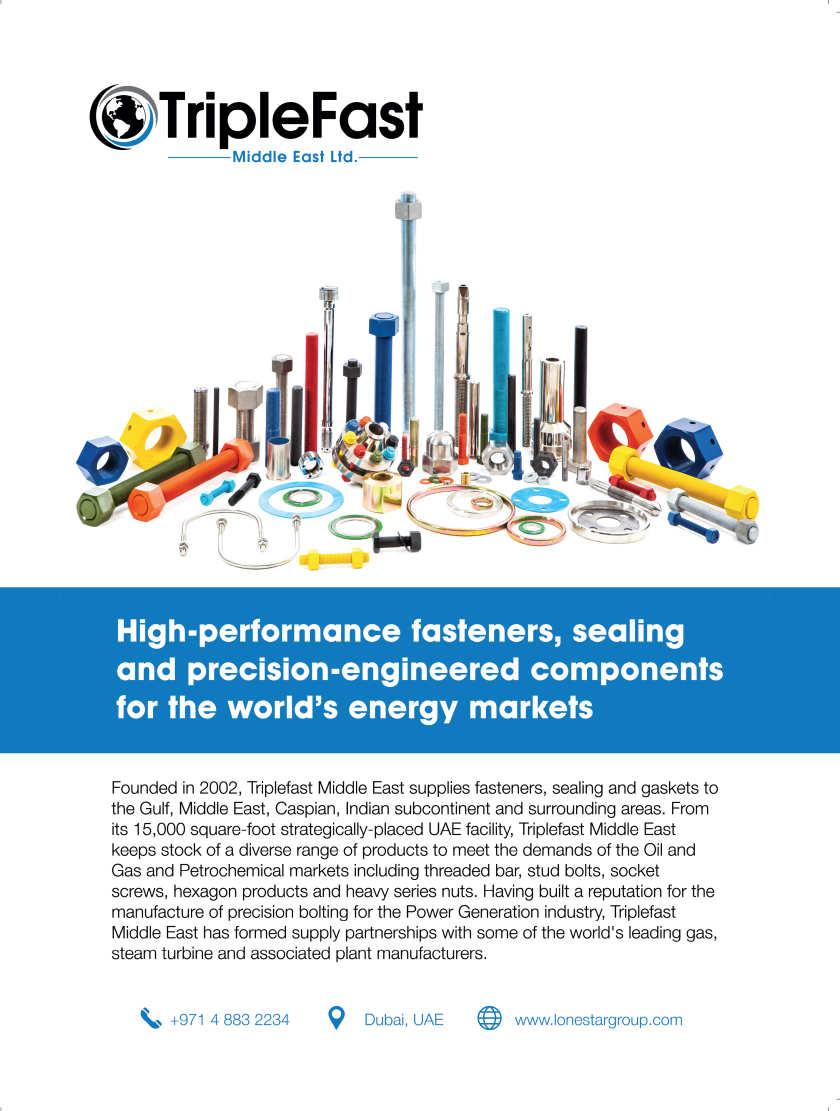
Today’s realities, tomorrow’s energy
HELD UNDER THE patronage of His Royal Highness Prince Salman bin Hamad Al Khalifa, the Crown Prince and Prime Minister of the Kingdom of Bahrain, the event features a world-class exhibition and an exceptional strategic and technical conference.
MEOS GEO is built upon a 40+ year successful track record of providing a platform to share ideas, experiences, and solutions for oil and gas. The merger of the Middle East Oil & Gas Show (MEOS) and the Middle East Geosciences Conference & Exhibition (GEO) captures the upstream industry’s full value chain under one roof, offering an unparalleled opportunity to demonstrate a range of technical expertise and innovative solutions across many disciplines. Supported by major operators, government and industry, MEOS GEO unites the power of expertise, knowledge and innovation to address today’s realities and tomorrow’s energy future.
This next-generation energy event will take place at Exhibition World Bahrain, a new state-of-the-art purpose-built venue for events of this magnitude. 15,000+ global energy professionals will convene in Bahrain including NOCs, IOCs, oilfield services companies, technology providers and an unparalleled speaking faculty of global thought leaders.
The MEOS GEO exhibition will play host to giants of the oil and gas sector such as ADNOC, Tatweer Petroleum, KPC, PDO and Saudi Aramco, along with start-ups with the power to transform the industry at the newly introduced Start-Up Village. The event will showcase the products, services and solutions that are driving mega energy projects forward.
New features in 2023 include a presentation of new technologies in the Transformation Hall, an area dedicated to innovative solutions from big tech powerhouses.
Decision-makers and key buyers form strategic partnerships and identify business opportunities in the Middle East and beyond.
The American Association of Petroleum Geologists (AAPG), the Society of Petroleum
Engineers (SPE), and Informa Markets will unite to stage one of the largest and most influential conferences the region has ever witnessed. The theme of the conference

‘Today’s Realities, Tomorrow’s Energy’ reflects the current landscape of the evolving industry and future solutions, where new technologies, efficiency developments, innovations, and 4IR and AI implementations will be showcased. The strategic conference will feature high-level panel sessions on topics including sustainability, investments, supply chain, geopolitics / supply interruptions, technologies and integration. The technical conference will feature 400+ technical presentations devoted
to exploration geology and geophysics, unconventional resources, drilling and well testing, reservoir characterisation and modelling, production and facilities, and more.
Research, insights and best practices from pioneers, innovators and policymakers will address today’s most pressing industry issues. Find out about the region’s mega projects, case studies and the technologies that are reengineering operations.
“This year’s selected technical and panel sessions are not only based on topics important to the oil and gas business, but the interlace of global matters and our industry,” said the message from the MEOS GEO executive chairs Faisal AlNughaimish, Saudi Aramco (conference chair); Andrea Cozzi, Eni (conference co-chair); and Mohamed Rashed Al Zaabi, ADNOC (conference co-chair).
“Everyone is encouraged to attend and join the discussions and collaborations, while also taking advantage of the two shows in a combined venue.” n
For further information, see the website at www.meos-geo.com
The event will bring together 15,000+ global energy professionals.
The Middle East Oil, Gas and Geosciences Show (MEOS GEO), the premier upstream oil & gas and petroleum geosciences event in the region, will take place from 19-21 February 2023 in Manama, Bahrain.
MEOS GEO 6 oilreview.me Issue 1 2023
Everyone is encouraged to attend and join the discussions and collaborations.”
Image Credit : informa markets

Emerson to automate ethane cracker
EMERSON WILL PROVIDE automation technologies, software and analytics for the Ras Laffan Petrochemical Complex in Qatar as part of a consortium with Viasat Energy Services, a division of global communications company, Viasat.

The US$6bn integrated polymers project, a joint venture between QatarEnergy and Chevron Phillips Chemical, is currently under construction and scheduled to go online in late 2026.

The project is QatarEnergy's largest investment ever in the country’s petrochemical sector. The complex will include an ethane cracker with a capacity of 2.1mn tonnes of ethylene per year, making it the largest ethane cracker in the Middle East and one of the largest in the world, as well as two high-density polyethylene derivative units with a total capacity of 1.7mn tonnes per year.
Emerson will deliver integrated process control and safety systems that leverage advanced predictive technologies to reduce operational complexity and minimise project risk through its DeltaV distributed control system and Rosemount gas analyser solutions. Viasat will design and provide an integrated telecommunications infrastructure for the entire Ras Laffan facility.
Downstream event to take place in Bahrain
HELD UNDER THE patronage of HRH Prince Salman bin Hamad Al Khalifa, Crown Prince and the Prime Minister of the Kingdom of Bahrain, the second edition of the GDA International Downstream Conference & Exhibition, the leading Middle East strategic forum for downstream professionals, will take place from 13-15 February 2023, Exhibition World Bahrain.
Over three days, 5,000 industry leaders, operators, and service providers will be among many to discuss the latest innovation and technologies, the future of the downstream sector, sustainable solutions, optimisation, margin improvement, and capital efficiency. The conference will also address global business challenges, sharing best practices to unlock potential opportunities through partnerships. From networking to knowledge exchange, the GDA Conference and Exhibition will spotlight market trends, lessons learned, and best practices to foster excellence and drive advancement through industry collaborations. Also taking place as a side event is the Youth Programme 'YouChemE' which will provide the youth with a unique opportunity to network with leading downstream professionals to prepare them for the workplace. For further information see www.gdaconference.org
Penspen reports US$65mn worth of new contracts
PENSPEN REPORTED NEW contract sales of US$65mn during the second half of 2022, including 28 new contracts in the Middle East.
Neale Carter, executive vice president for the Middle East, Africa and Asia Pacific Regions, said, “The MEA team is further solidifying its position as a trusted adviser for deep engineering knowledge on energy projects, delivering real value and consistent success across engineering and project management services in the region. This has resulted in several new framework agreements with major national oil companies.”
Key contract highlights are as follows:
• 77 new contracts in the UK and Europe across the Asset Integrity, Asset Management, and Engineering service lines including a hydrogen assessment gap analysis and blending facility design for a national gas system in Europe
• 28 new contracts in the Middle East across the Project Management Consultancy, Detailed Engineering, and Asset Integrity service lines, including project management and consultancy for onshore services, engineering services for a CO2 recovery and injection project, risk-based asset integrity implementation for refining, and several multi-year framework agreements across all services for a major national oil company
• 27 new contracts in North America and Latin America across the Asset Management and Asset Integrity service lines.
STRYDE secures seven-figure contract for seismic survey
INTERNATIONAL SEISMIC TECHNOLOGY company, STRYDE, has been awarded a multi-million-dollar contract for the supply of an 80,000-channel nodal acquisition system in the Middle East.
The contract is with the world’s largest geophysical services provider, BGP, who will lease STRYDE’s containerised Compact System for use on a high-density 3D acquisition project in Oman. This deal follows multiple contracts between BGP and STRYDE globally.
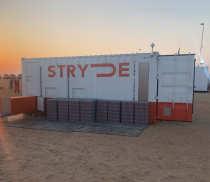
Along with the company’s differentiated nodal technology, STRYDE will supply its Compact System, a containerised node management solution that allows one operator on shift to rotate around 13,000 nodes every 24 hours. This is made possible by STRYDE’s built-in node charging and data-harvesting systems, allowing the client to drive further efficiencies on this high-density 3D seismic survey.
Sam Moharir, STRYDE’s head of business development, MENA said, “STRYDE Nodes help with denoising seismic data acquired in desert environments and enable large-scale highdensity seismic surveys. Due to the system’s compact size and reduced cost, STRYDE is the only feasible solution for high-density land seismic acquisition, capable of handling the frequency-band overlap between noise and effective signals.”
An additional feature of the Compact System allows for a minimal seismic camp footprint, with reduced crew sizes and vehicles. In turn, this significantly lowers HSE risk exposure in the field. Housed in a single standard 20ft shipping container, the innovative Compact System allows flexibility to expand the channel count up to 150,000 nodes without needing additional infrastructure or operators in the Compact container.
News
The project is QatarEnergy’s largest investment in the petrochemical sector.
STRYDE compact Node Management System.
8 oilreview.me Issue 1 2023
The contracts are worth up to US$65mn.
Image credit: Emerson
Image credit: STRYDE
Image Credit: Penspen
Middle East Energy to turbo-charge the transition
Middle East Energy, the exhibition and conference powerhouse, is set for the biggest showing in its 48-year history when it opens at the Dubai World Trade Centre from 7-9 March 2023.

FOR THE FIRST time, the event will host a strategic conference, the only high-level forum exclusively focused on unpacking today’s complex opportunities and challenges for senior energy and utilities decision-makers in the Middle East and Africa (MEA).
The conference, themed ‘Powering The Energy Transition’, has been launched by Middle East Energy organiser, Informa Markets, as energy leaders look for fresh insights into enabling sector transition, efficiency, supply resilience and sustainability.
“For almost 50 years, Middle East Energy has brought together global buyers and sellers who have advanced the sector, but the 2023 event comes at a pivotal time in the industry’s evolution as worldwide energy challenges impact economic and social performance, fuelling intense governmental and consumer pressure to find solutions,” explained Azzan Mohammed, Informa’s exhibition director, Energy portfolio – MEA.
Over the event’s three days, the Strategic Conference will deep-dive into the planning and policies that will drive MEA’s future energy outlook and examine ways of decarbonising the energy and utilities sectors, and drive industry-wide digitalisation and innovation.
Unprecedented challenges such as a growing demand for hydrogen, and need for investment and collaboration to tackle carbon emissions has boosted interest in the event –more than 20,000 energy professionals are now forecast to attend More than 800 exhibitors from 170 countries are so far confirmed for the exhibition’s five dedicated product sectors of backup generators and critical power, transmission and distribution, energy conservation and management, smart solutions as well as renewables and clean energy.
“Registrations are pouring in, and all the signs are for a record turnout,” added Mohammed. “And with companies looking to invest in alternative and technology-led solutions, we also envisage the show beating the onsite business deals tally of the last show which totalled over US$705mn.”
Alongside the Strategic Conference, the event will also host the Intersolar Middle East Conference, in partnership with Intersolar and Electric Energy Storage, to unearth insights into the transformative global dynamics of renewables. The Forum is designed to be an unrivalled platform for both public and private sectors to explore critical issues, key developments, investment opportunities, and rising energy ecosystem trends.
Technical Seminars will explore the practical application of the latest sector research, innovation, and technological advancements empowering stakeholders building, operating, and maintaining power plants, as well as transmission and distribution grids. Meanwhile, newly introduced CEO Roundtables will see industry leaders engage in peer-to-peer discussions focused on emerging market opportunities in the renewables and critical and backup power sectors, as well as grid investment plans.
Driving business
The 2023 event will also see the return of Middle East Energy’s successful Hosted Buyer Programme, which brings key industry
stakeholders, investors, and suppliers from across the globe in direct contact with more than 100 direct purchasing authorisers and influencers to explore business opportunities. The programme has a strong track record of business development and has won acclaim from both sides of the buying equation.
Caroline Chema Eric, a public-private partnerships consultant with the World Bank, was hosted at the last event and noted, “The Hosted Buyer programme was incredible, from the preparation and logistics to attend the show and conference. I was looking for contacts as the World Bank is preparing a number of projects in the power sector and my role is to find credible private sector actors for various components from generation to transmission distribution and also product suppliers, and I found them.”
Sponsors include Al Fanar, Baudouin, and Ducab at this year’s event. ■
Find out more about Middle East Energy at: https://www.middleeastenergy.com/en/home.html
Register for the event at: https://middleeastenergy.me/RegisterNow
Events Issue 1 2023 oilreview.me 9
More than 800 exhibitors from 170 countries are confirmed for the exhibition's five dedicated product sectors.
Image Credit Middle East Energy
Rystad Energy forecasts low-carbon investment to rise by US$60bn in 2023


RESEARCH PUBLISHED BY
Rystad Energy has estimated that spending on low-carbon projects will increase by US$60bn in 2023, spurred on primarily by increased focus on wind; hydrogen; and carbon capture, utilisation and storage (CCUS).
Although this spending is 10% higher than 2022 (a year which saw investments in green sectors overtake oil and gas spending for the first time), this actually represents a deceleration from recent years which averaged a 20% annual increase. This decline has been attributed to costconscious developers tightening their purse strings after two years of instability and soaring prices.
Nevertheless, as inflationary pressure weakens, Rystad expects spending to rebound. Investments in the geothermal, CCUS, hydrogen, hydropower, offshore and onshore wind, nuclear and solar industries are set to hit US$620bn in 2023, up from about US$560bn last year.
Solar and wind lead the way
Solar and onshore wind will contribute the most from the low-carbon investment areas with spending on solar investments to total US$250bn this year, rising only 6% over 2022. However, thanks to the falling cost of polysilicon, the primary cost driver of solar PV cells, capacity growth will be more substantial. Despite a relatively insignificant rise in investment value, installed capacity is expected to grow by roughly 25% to 1,250GW.

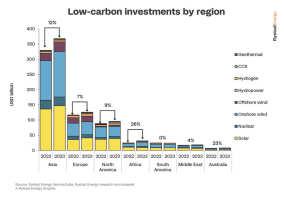
Rystad have indicated that spending growth will vary widely across industries. Hydrogen and CCUS are expected to see the most significant annual increase, growing 149% and 136%, respectively. Total hydrogen spending will approach US$7.8bn in 2023, while CCUS investments will total about US$7.4bn. Onshore wind investments are projected to increase by 12% to about US$230bn, while offshore wind spending is expected to jump 20% to US$48bn.
In contrast, the hydropower market is expected to shrink over 2022, while nuclear investments are forecast to stay relatively flat. Expenditure in geothermal is expected to jump significantly – about 45% – albeit from a relatively low starting position.
Audun Martinsen, head of supply chain research with Rystad Energy, commented, “The weaker-than-expected growth is not a reason to panic for those in the low-carbon sector. Rampant inflation typically triggers fiscal restraint across industries, and spending will likely bounce back in the coming years. The outlook for hydrogen and CCUS is especially rosy as technology advances, and the large-scale feasibility of these solutions improves.”
In regards to individual segment types, prospects for operations and maintenance companies are looking bright, with Rystad predicting them to achieve the most growth this year at 16%. Meanwhile, logistics and vessel companies are estimated to take in 15% more this year while spending on equipment, materials, engineering and construction sectors are expected to rise by about 9% annually.
By region, Africa is set to be the biggest winner of these trends with Rystad forecasting the continent to attract the highest investment growth with a 26% increase (mainly driven by projects in Egypt).
Australia takes second spot with 23% growth, Asia with 12% and North America with 9%. Europe, struggling with high inflation and supply chain issues is expected to garner investment growth of just 7%.
Hydrogen shifting towards low-emissions solutions
A JOINT STUDY conducted by the European patent Office (EPO) and the International Energy Agency (IEA) has indicated hydrogen technology development is shifting towards lowemissions solutions.
The report provides a comprehensive analysis of innovation in all hydrogen technologies – from hydrogen supply to end-use applications – and indicates that innovators are responding to the need for competitive hydrogen supply chains.
Technologies motivated by climate concerns accounted for nearly 80% of all patents related to hydrogen production in 2020, with growth driven chiefly by a sharp increase of innovation in electrolysis. The most innovative regions are now competing to host the first industrial roll-out phase, with the data suggesting that Europe is gaining an edge as a location for investment in new electrolyser manufacturing capacity.
The study, which presents the major trends in hydrogen technologies from 2011 to 2020, found that global patenting in hydrogen is led by the EU and Japan (accounting for 28% and 24% respectively of all international patent families) while the US registered 20% of all hydrogen-related patents. Patenting activity in hydrogen remained modest but still on the rise in South Korea and China. Other countries generating large amounts of hydrogen patents include the UK, Switzerland and Canada.
Hydrogen production technologies accounted for the largest number of hydrogen patents over the 2011-2020 period. While global hydrogen production is currently almost entirely fossil-based, the patenting data shows that lowemissions innovations generated more than twice the number of international patents across all segments of the hydrogen value chain than established technologies.
EPO president, António Campinos, commented, “If hydrogen is to play a major role in reducing CO2 emissions, innovation is urgently needed across a range of technologies. This report reveals some encouraging transition patterns across countries and industry sectors, including Europe’s major contribution to the emergence of new hydrogen technologies. It also highlights the contribution of start-ups to hydrogen innovation, and their reliance on patents to bring their inventions to market.”
News 10 oilreview.me Issue 1 2023
Rystad estimates Africa will attract the highest investment growth with a 26% increase.
Image Credit: Rystad Energy
The 10% spending growth actually represents a deceleration from recent years which averaged a 20% annual increase.
Image Credit: Rystad Energy
TotalEnergies commences gas production in Oman onshore field
TOTALENERGIES HAS ANNOUNCED the start of gas production from the Mabrouk North-East field in the onshore Block 10, Oman.
TotalEnergies holds a 26.55% interest in Block 10, with OQ holding 20% and operator Shell holding 53.45%.
Gas production is expected to reach 500mn standard cubic feet per day by mid-2024. The produced gas will supply the Omani gas network, feeding both local industry and LNG export facilities. This production startup follows the signing of the concession agreement in December 2021.
The company has also signed an agreement with Oman LNG for the purchase of 0.8mn metric tons of LNG per year over a period of 10 years starting from 2025. This new contract will contribute to TotalEnergies' LNG integrated portfolio and reinforce its flexibility, by allowing to address both the European and Asian markets. This LNG will contribute to the reduction of emissions into the atmosphere since it will allow the electric utilities who purchase this gas to substitute it for coal, thus avoiding CO2
“These announcements are consistent with the ambition of TotalEnergies to contribute to the energy transition and reinforce its longstanding partnerships with both Oman LNG and the Omani State”, said Patrick Pouyanné, chairman and CEO of TotalEnergies. “TotalEnergies deploys in Oman its multi-energy strategy in oil, gas and renewables and so participates in the sustainable development of the country’s natural resources.”
TotalEnergies has recently signed 30 MW of solar projects in Oman including a project to supply Sharqiyah Desalination Company (17 MW), in joint-venture with Veolia.
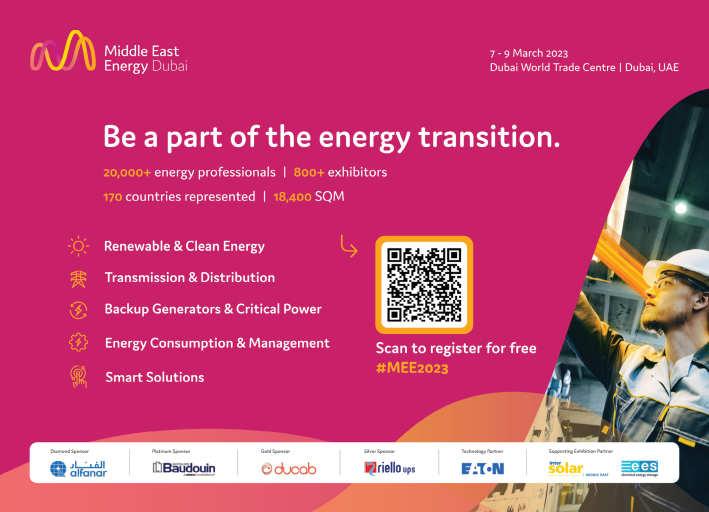
News
Issue 1 2023 oilreview.me 11 Image credit: TotalEnergies
The moves are in line with the company’s growth strategy in gas and LNG.
Satellite monitoring helps tackle methane emissions in Iraq

THE OIL & GAS Climate Initiative (OGCI) has announced successful results from its pilot programme with greenhouse gas monitoring company, GHGSat, and Norwegian climate consultancy Carbon Limits. The initiative has shown that satellite technology has significant potential in tackling methane emissions for oil and gas operations.
The nine-month pilot used GHGSat satellite technology to cover six oil fields in Iraq from late 2021 to 2022 to detect methane emissions. Once detected, OGCI and Carbon Limits engaged with local operators on the ground to help reduce the emissions by identifying the sources as well as relevant available mitigation technology and solutions.
OGCI vice president, Strategy & Policy, Julien Perez, said, “This innovative pilot programme led by OGCI and GHGSat has clearly show that satellite technology alongside direct engagement and knowledge sharing with local operators has enormous potential to make significant and cost-effective reductions in methane emissions.
“We’re expanding the programme to 20 additional sites in Iraq, Kazakhstan, Algeria and Egypt.”
Aramco launches subsidiary firm Aramco Trading Americas
ARAMCO HAS ANNOUNCED the 100% acquisition of Motiva Trading by the Aramco Trading Company (ATC), as well as the launch of Aramco Trading Americas LLC (ATA); a whollyowned subsidiary of ATC based in Texas.
With ATA acting as ATC’s regional office, there is the opportunity for the company to expand trading across North and South America and increase its existing client base.
Mohammed K. Al-Mulhim, CEO and president, ATC, commented, “The acquisition of Motiva Trading and the establishment of Aramco Trading Americas are a giant step towards executing our ambitious global growth strategy, which aims to expand our geographic reach and scale of operations, while further strengthening our product flexibility and optionality.”
Under the purchase agreement, ATA will be the sole supplier and ‘offtaker’ of Motiva Enterprises, which owns North America’s largest refinery with a crude refining capacity of 636,000 bpd.
The launch of ATA gives ATC the opportunity to bring its business closer to customers and provide them with significant access to the world’s robust hydrocarbon system.
ADNOC announces worlds-first CO2 injection project
AT THE ABU Dhabi Sustainability Week (ADSW), ADNOC has announced it has begun work on the world’s first fully sequestered carbon dioxide injection well in a carbonate saline aquifer. The project, which is expected to begin injecting CO2 in Q2 2023, marks an important step in ADNOC’s commitment to decarbonising its operations by 25% by 2030 and become net zero by 2050.
Yaser Saeed Almazrouei, ADNOC Upstream executive director, said, “Carbon capture and storage will play an important role in reducing emissions and achieving global climate goals, and ADNOC is building on its leadership position in this area as we continue to drive decarbonisation across our operations.
“At Al Reyadah, ADNOC deployed the region’s first carbon capture project at scale and we are taking another tangible step to deliver on our US$15bn decarbonisation action plan with the world’s first fully-sequestered CO2 injection well.”
The project will contribute to the production of lower-carbon ammonia; and effective and costcompetitive hydrogen carrier that can be scaled up quickly and has lower carbon-intensity compared to other fuels.
Once operational, the project will initially full sequester a minimum of 18,000 tons for annum of CO2 captured from UAE operations for injection into Abu Dhabi’s onshore carbon aquifers, supporting ADNOC’s efforts to safely capture and store CO2

ABU DHABI CHEMICALS Derivatives Company RCS Ltd (TA’ZIZ) and one of the world leading producers of methanol, PROMAN AG (Proman), have signed a shareholder’s agreement to develop the UAE’s first world-scale methanol production facility.

Located in Al Ruways Industrial City, Abu Dhabi, the facility will have an anticipated annual capacity of up to 1.8 million tons; enough to meet the growing domestic and international demand for the versatile commodity. The substance has a variety of uses, including fuels, solvents, pharmaceuticals and construction materials, and shows growing potential as a lower-emission fuel, especially for maritime uses.
Khaleefa Yousef Al Mheiri, TA’ZIZ acting chief executive officer, said, “This agreement continues to build momentum at TA’ZIZ and advances our mission to diversify the UAE’s economy and accelerate industrial development. Our partnership with Proman underlines the UAE’s attractiveness as a destination for international partners and investors as we progress plans to produce methanol at world-scale in Al Ruways.”
Menthol production in the UAE is in line with the Ministry of Industry and Advanced Technology’s mission to diversity the economy and accelerate industrial development. The growth in this chemical is expected to be driven by Africa’s and Asia’s emerging economies, while the UAE will rely on its support to decrease the reliance the region has on imports, enabling local manufacturers to ‘Make it in the Emirates’.
Proman’s managing director, Richard Brink, commented, “With growing global demand for methanol as a cleaner fuel, this agreement demonstrates the huge potential for the TA’ZIZ Industrial Chemicals Zone and Abu Dhabi’s evolving downstream industry.”
UAE’s first methanol facility is under development
News
Satellite-based monitoring can help operators to reduce methane emissions.
Richard Brink, Proman, and Khaleefa Yousef Al Mheiri, TA’ZIZ.
12 oilreview.me Issue 1 2023 Image Source: Adobe Stock Image Source: ADNOC Image Source: ADNOC
ADNOC’s site for the injection well project in Abu Dhabi.
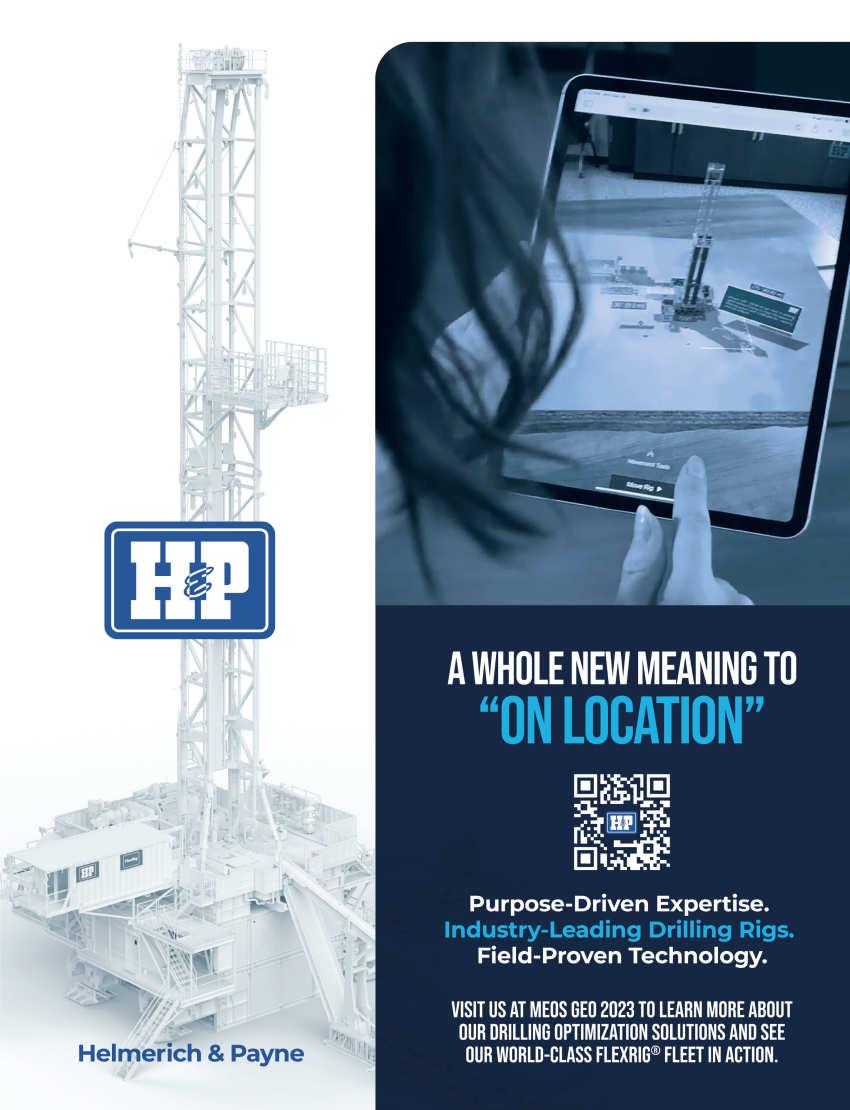
Factors shaping the future of crude oil

Economist Moin Siddiqi assesses prospects for the oil markets this year.
THE OIL MARKET still faces multiple uncertainties after a turbulent year. Several factors are at play which impact the short and medium-term trends in oil prices. They include notably macro-economic headwinds; central banks’ aggressive rate-hiking to rein in inflation which is at the same time threatening global economic activity; Europe’s energy crisis thanks to the fallout from the Ukraine conflict; the uneven Covid recovery, especially in the world’s top oil importer (China); supply chain issues; and lack of investments into the discovery of future hydrocarbons supply.
The International Monetary Fund (IMF) predicts a global output loss of around US$4 trillion between now and 2026 (equivalent to the size of Germany’s economy). It envisages a third of the global economy slipping into recession this year. Manufacturing activities globally are in contraction territory, thus less energy usage. A strong greenback, which makes dollar-denominated crude oil expensive for foreign buyers, is also weighing on demand. While inventories (after build-up during the pandemic) are steadily falling, leading to tighter diesel markets.
Crude oil futures fluctuated wildly over the past year from ‘backwardation’ (which typically occurs at times of supply deficit) to a ‘contango’ structure (signalling a weak demand or an oversupply). The Russian invasion of Ukraine drove backwardation to its steepest in history – Brent hitting US$140/barrel briefly in March 2022. Expectations of global slowdown or worse, a looming recession, pulled oil in different directions (contango), with prices steadily falling to the mid-US$80s at the time of writing.
Backwardation is where [near-term] crude futures trade at a premium to long-dated delivery, whereas a contango market occurs when future price is more expensive than spot price. The current situation indicates oil could drop further because of well-supplied markets in the Atlantic Basin and north-west Europe.
Two contentious issues today are a possible ‘supply crunch’ sending oil higher, and ‘recession-induced’ demand destruction sending oil lower. The latter is being underestimated based on current macroforecasts. Most analysts fall into one of two camps. While both scenarios have merits, in the near-term, however, weak demand rather than supply-risk premium carries more weight in energy markets.
While the US economy is likely to slow, a contraction in the euro area and UK economies will dampen oil demand. However, the impact of the U.S. and Europe downturn will be evident by Q3 2023. The International
GlobalGDPgrowth Worldtradevolume Growthinoilconsumption
Energy Agency (IEA) expects any downturns to be mild – unlike the global recession caused by the pandemic – thereby reducing oil’s downside risk for the year.
Likely market scenarios
Bullish signals: The European Union embargo on Russia; OPEC+ restrictive supply management plus ‘dwindling’ spare capacity; faster than expected global economic recovery; China’s reversal of its zero-Covid policy; and escalating geopolitical tensions. Global supplies could experience more tightness over the coming months.
“We expect the European ban on seaborne Russian crude and refined products (coming into force on 5 February) to result in a drop of Russian production of at least 1mn bpd in 2023, with Russia having difficulties in finding alternative markets," says UBS Group AG. A reduced Russian oil and product output will further disturb oil supply and oil trade
-15 -10 -5 0 5 10 15 2020202120222023 -9.3 -8.2 5.9 6.2 10.6 4 2.9 1.9 1.6 1.7 1 -3.2
Oil Market 14 oilreview.me Issue 1 2023
The IEA expects any downturns to be mild, thereby reducing oil’s downside risk for the year.”
Sources: World Bank Global Economic Prospects, January 2023 and Energy
Administration Oil demand growth forecasts 2023: EIA
Oil demand strongly correlated to global economic activity (annual % change)
Information
(1.05mn
bpd); IEA (1.9mn bpd); OPEC (2.2mn bpd).
flows, according to Deloitte Canada. Russia boasts the world’s third-largest oil refining capacity (6.86mn bpd) after the USA (17.94mn bpd) and China (16.99mn bpd), according to bp 2021 data.
The catalyst is China, where demand is poised for a medium-term rebound as authorities remain committed to boosting consumption recovery. “The pent-up demand out of China is going to be enormous; that could swing demand by at least 1mn bpd and could make the difference between an oil price forecast of US$95-105 versus US$120130,” says Energy Aspects. S&P Global agrees: China is “one big wild-card on the upside that hangs over the oil market.” A full reopening in China alone could provide the biggest buffer against global recession fears.
Markets, however, have priced in a global slowdown, which is partially reflected in oil prices already. There could be room for optimism in the second half of 2023, providing jobs and consumer spending data in advanced economies exceed expectations with a continued easing of price pressures, thus boosting hopes for a ‘soft landing’ in the USA and Europe, coupled with growth revival in emerging Asia. Global growth will improve in the second half of 2023 and into 2024, says Gita Gopinath, IMF first deputy managing director.
Spare capacity globally is currently very low – mostly confined to two core OPEC producers (Saudi Arabia and the United Arab Emirates). Moreover, global oil inventory also remains at its lowest level since 2004. Both factors, plus reduced refining capacity and investment, mean current global supplies may be insufficient to cope with an unexpected demand surge later in Q4 or early 2024.
Russian production, which totalled 10.94mn bpd in 2022 (the world’s second largest) will see further declines due to a loss of foreign technology and investment, but long-cycle deepwater and conventional
production, too, face decline rates because of sharply lower capital expenditure (capex). This leaves only U.S. shale and core Gulf producers: Saudi Arabia, United Arab Emirates (UAE) and Kuwait as the engines of near-term oil supply growth. U.S. oil output is forecast to grow by 550,000 bpd in 2023 to around 12.41mn bpd (Energy Information Administration data) – of which two-thirds
Broad slowdown across the world's major economies (Annual % change)
constitutes shale oil.
Fuel-switching is oil supportive; natural gas prices remain exceptionally high in Europe and Asia, pushing industrial users to switch from more expensive natural gas to petroleum products such as fuel oil or diesel, increasing demand for crudes. The U.S. government is expected to start buying back oil for its Strategic Petroleum Reserves (SPR), which could provide a demand boost of around 200mn barrels.
There is risk of production outages from five fragile producers (Iran, Iraq, Nigeria, Libya, and Venezuela), all struggling with domestic problems, with combined output of 9.88mn bpd in 2022 (OPEC data), which could lead to a tighter oil balance.
“We remain constructive on oil prices driven by recovering demand (China reopening, aviation recovering) amid constrained supply due to low levels of investment, risks to Russia supply, the end of SPR releases, and slowdown of U.S. shale,” says Morgan Stanley. The latter is due to capex restraint, rising costs and labour shortages – being reflected in a slower U.S. supply growth compared to previous upcycles.


Bearish signals: uncertain demand outlook; prolonged recessions in many economies; Covid fears in China; the peaking of the U.S. dollar (making oil imports less expensive) and de-escalation of geopolitical tensions in Eastern Europe and the Middle East.
A hard landing (i.e. deep prolonged recession) in developed markets alongside tepid growth in emerging Asia would hit the oil market hard. In a recent note, Barclays cautions in the event of a slump in global manufacturing activity (like the 2008-2009
2.54 2.71 3.06 3.77 4.45 5.13 5.71 10.44 10.94 11.86 02468101214 Iran Kuwait UAE Brazil Iraq China Canada Saudi Arabia Russia USA Oil Market Issue 1 2023 oilreview.me 15
Current global supplies may be insufficient to cope with an
unexpected
demand surge.”
Top 10 2022 crude oil producers (mn bpd)
Source: EIA, Short-term Energy Outlook, January 2023
Projections Real GDP growth 2021 2022 2023 U.S. 5.9 1.9 0.5 Euro Area 5.3 3.3 0.0 Japan 2.2 1.2 1.0 Advanced Economies (avg) 5.3 2.5 0.5 Emerging markets and developing economies* 6.7 3.4 3.4 of which: China 8.1 2.7 4.3 India 8.7 6.9 6.6 Saudi Arabia 3.2 8.3 3.7 Brazil 5.0 3.0 0.8
Source: World Bank Global Economic Prospects, January 2023
*The emerging and developing economies are the biggest oil growth engines. China accounts for 50% of the total oil demand growth.
crisis), oil demand would fall by 1-2mn bpd, which in turn, would reduce oil prices by US$15-25/bbl. from its current forecast of US$98. “The cyclical demand trends are pointing south for oil,” Barclays says.
“We have an underlying view that we will see an imbalance between supply and demand across 2023, with significantly more supply coming into the market than demand, leading to inventory builds, which should weigh on prices, so that we see prices ending the year on average lower than the beginning,” says Citi Group.
There is a possible supply uptick of around 1.3mn bpd from Iran (if sanctions are lifted). While resolution of Russia-Ukraine conflict would abate Europe’s energy crisis, a return to pre-war Russia oil and gas trade flows seems improbable.
A closer look at demand/supply dynamics suggests that small global surpluses (not deficits) are likely during 2023 – indicating that the oil market is oversupplied structurally –thus weighing on prices. However, a combination of OPEC+ supply cuts (including Russia sanctions) and possible return to durable growth in the ‘big three’ (the USA, Eurozone, and China) could prompt a market imbalance by Q4. The IEA expects a tighter balance, with demand surging by 1.9mn bpd versus supply growth of 1mn bpd in 2023.
This year’s average forecast for Brent (global benchmark) from 1,000 energy professionals compiled by Reuters (as of January 16 2023) is US$87/bbl. Major investment banks are also quite bullish, seeing oil trading at between US$80-90 in 2023 (see footnote).
Chronic underinvestment



The oil industry must increase investment in upstream capacity and new production in order to avoid future volatility, stresses OPEC’s secretary general Haitham Al Ghais.
Before 2016, capex into new projects topped US$500bn/year. Upstream investment more than halved between 2014 and 2021. Non-OPEC upstream sector investment in 2023 is projected at US$459bn, up 8% on last year.
Lower capex is keeping a lid on supply growth. OPEC’s World Oil Outlook 2022
Key drivers of oil demand growth and decline in 2023 (mn bpd)
showed that the global oil sector needs cumulative investment of US$12.1 trillion in the upstream, midstream, and downstream through 2045, equating to more than US$500bn/year. In the longer run, there are plenty of factors that could lead to a major supply crunch. The head of Saudi Aramco Amin Nasser cautions, “We are facing a substantial supply shortfall in the long term if global upstream investment does not start to surpass accelerating rates of natural decline”.The IEA’s World Energy Outlook 2022
Global oil demand and supply balance (mn bpd)
described the energy crisis as “a shock of unprecedented breadth and complexity”. The report defines it not as a transitory shock but a fundamental change that will continue to roil the global energy markets for years to come.
In sum, oil fundamentals are far more positive than in early 2020. There are no threats of price wars by producers, collapsing demand due to Covid-related economic doldrums or/and major supply expansion in pipelines. Crude oil (an indispensable commodity) still plays an important role in the global economy, despite the continued efforts to find alternative green energy sources.
The OPEC+ alliance seems resolved to defend a US$80 floor under oil prices (with a new production cut if necessary). That said, a cheaper oil scenario (below US$70) would play out in case of severe economic headwinds. Indeed, the global economic momentum largely dictates market sentiment regarding demand outlooks.
Footnote: Oil price predictions, 2023 (Brent crude), US$/bbl:
Morgan Stanley (100); Barclays (98); Goldman Sachs (98); Fitch Solutions (95); The Bank of America (90): S&P Global (90); JP Morgan Chase & Co. (90); World Bank (88); U.S. EIA (83); Citi Group (76); Credit Suisse (63). The uncertainty around projections is high given geopolitical variables, the Covid-19 situation in China and the direction of the global economy. n
Oil Market 16 oilreview.me Issue 1 2023
Oil fundamentals are far more positive than in early 2020.”
Projections 2020 2021 2022 2023 Total production * 93.84 95.70 99.98 101.10 Total petroleum consumption 91.81 97.56 99.43 100.48 Global oil balance 2.03 -1.86 0.55 0.62 OECD commercial inventories (mn barrels) 3025 2640 2786 2892 Brent spot (avg) US$/bbl. 40.84 70.89 100.94 83.10
oil, lease, condensate, shale oil, oil
natural gas liquids
biofuels.
Source: EIA, Short-term Energy Outlook, January 2023 *Crude
sands,
&
Change over 2022 Oil usage in 2023 China 0.53 15.69 Middle East 0.28 9.45 India 0.22 5.25 U.S 0.17 20.44 Europe 0.15 14.2 Africa 0.10 4.52 Brazil 0.01 2.95 Canada -0.02 2.28 Japan -0.07 3.29 Mexico -0.07 1.77 Russia -0.08 3.32 Source: EIA, Short-term Energy Outlook, January 2023
pace of demand surge by regions in 2023 (mn bpd) Total Non-OECD 1.89Total OECD*0.33 of which: China0.51Americas 0.26 India0.25of which: U.S.0.15 Other Asia0.35Europe0.03 South America0.15Asia-Pacific0.04 Middle East0.33 Africa0.19 Source: OPEC Monthly Oil Market Report, January 2023 *Organisation for Economic Cooperation & Development, representing industrial nations
The
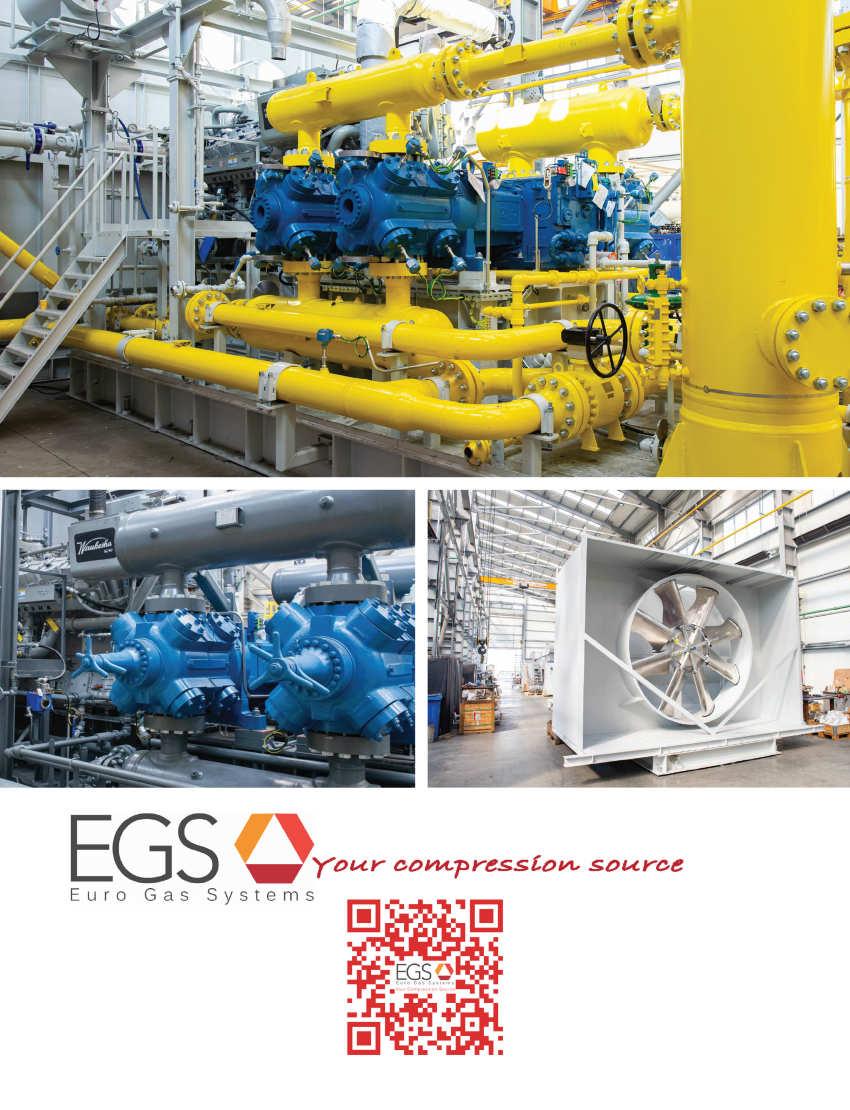
From hydrocarbons to hydrogen
EGYPT’S GAS ECONOMY has roared back to life in the past few years, driven by a series of big offshore discoveries in and around the prolific Nile Delta area. This has powered the local economy and also revived exports, including the reboot of the North African country’s liquefied natural gas (LNG) facilities.
Eni, bp and other leading firms have poured billions of dollars in investment to unearth and harness Egypt’s new-found natural gas deposits. The new year started with a bang as well after Eni and Chevron announced a new offshore find in January with their Nargis-1 well.
It is still only early days in terms of development, but the new find builds on multiple other discoveries in the Eastern Mediterranean in recent years.
The latest wave of investment and excitement was triggered by Eni’s discovery of the giant Zohr field back in 2015. The new Nargis-1 well encountered 200 net ft of gasbearing sandstones and will be developed utilising other facilities and infrastructure nearby, Eni said in a statement, without mentioning any timescale.

Hydrogen hopes
It is more good news for Egypt’s gas sector,
but officials are looking beyond hydrocarbons too. The government has made it a priority to explore alternative energy sources, in keeping with global plans to reduce carbon emissions, especially after hosting the COP27 climate conference in Sharm el-Sheikh at the end of 2022. Egypt has been proactive in rolling out utility-scale solar and wind farms to complement gas-fired power generation, though attentions are now turning to more advanced energy technologies, including hydrogen.
There appears to be a lot of momentum in this area too, with development finance groups pledging large sums of money and even some of the big oil names showing an interest.
At the COP27 summit, Egypt signed eight framework agreements to develop green hydrogen and ammonia projects with a number of well-known industry partners. Green hydrogen is produced by the
electrolysis of water, powered by renewable energy. The agreements signed were with companies including AMEA Power, Alfanar, TotalEnergies, Globeleq, EDF, Fortescue Future Industries, ReNew and Scatec, and are mainly concentrated around the Red Sea port of Ain Sokhna and the Suez Canal Economic Zone.
Going forward, Egypt hopes to position itself as a regional hub for the nascent hydrogen sector.
Egypt Green
Egypt looks to have plenty of support behind its ambitions too. The European Bank for Reconstruction and Development (EBRD) is supporting the decarbonisation drive with a US$80mn loan to Egypt Green to develop the country’s first green hydrogen facility.
Egypt Green is owned, built and operated by Fertiglobe, one of the largest seaborne exporters of combined urea and ammonia, Scatec ASA, a Norwegian power producer, Orascom Construction, and the state-owned Sovereign Fund of Egypt. The cash will be used to build a 100 MW electrolyser facility to be powered by renewable energy. When developed, it will deliver up to 15,000 tonnes of green hydrogen annually. This, in turn, will be used as an input for the production of
Egypt’s gas resources are a mainstay of its economy.
Despite Egypt’s gas sector roaring back to life in recent years it is other innovative niches, such as hydrogen, that may offer the greater potential long-term. Martin Clark reports.
Egypt 18 oilreview.me Issue 1 2023
Egypt hopes to position itself as a regional hub for the nascent hydrogen sector.”
Image
Credit : Adobe Stock
green ammonia to be sold on the Egyptian and international markets.

Ammonia production is energy intensive and responsible for around 1.8% of global carbon dioxide (CO2) emissions. At full capacity, the facility’s green hydrogen production could save more than 130,000 tonnes of CO2 emissions per year.
“We see a massive green hydrogen demand driven by strong policy support globally, and Africa is perfectly positioned to take advantage of its low-cost renewables and strategic position,” said Mikkel Tørud, chief financial officer at Scatec ASA.
bp’s diversification drive
The major oil companies in Egypt have also shown similar intent. In December, bp signed a memorandum of understanding (MoU) with the government to explore the potential for establishing a green hydrogen facility.Under the MoU, the energy giant will carry out studies to evaluate the technical and commercial feasibility of developing a multiphase, large scale green hydrogen export hub in Egypt, including exploring possible sites and locations.
The MoU was signed with Egypt’s New and Renewable Energy Authority (NREA), the Egyptian Electricity Transmission Company (EETC), the General Authority for Suez Canal Economic Zone (SCZONE), and the Sovereign Fund of Egypt for Investment and Development (TSFE).
Hydrogen is one of bp’s five energy transition growth engines, and the group is working on a portfolio of options for the
development of green and blue hydrogen projects globally.
“Expanding the remit of our business in Egypt is testament to bp’s long-term commitment to Egypt,” said Nader Zaki, BP’s regional president, Middle East and North Africa.
“This MoU builds upon Egypt’s endeavours to be a regional energy hub, and we are glad to be able to be a strategic partner to support the country’s green energy transition plans.”
The move into hydrogen builds on bp’s long-established presence in the country, where it has over US$35bn in investment already. It operates the West Nile Delta development, which includes five gas fields across the North Alexandria and West Mediterranean Deepwater blocks, and produces around 900 million cubic feet per day (mmcfd) of gas and 27,000 barrels per day (bpd) of condensate.
Gas search continues
While hydrogen may bring with it hopes for a new era in energy long-term, it is a niche that is still in its infancy, with high associated costs. For now, it is Egypt’s oil and gas that continue to keep the lights on in homes and businesses, and to keep the money rolling in.
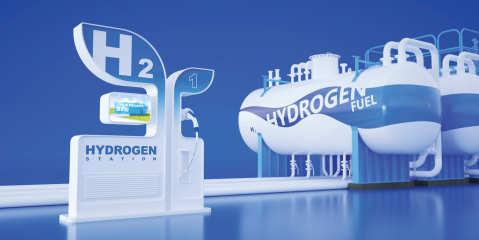
Upstream, there remains plenty of excitement in the field as drillers prepare to test new acreage. Among them is Shell, which is preparing a multi-well drill programme on frontier acreage this year. Two Shell companies, BG Delta and BG International, in January signed a contract with Stena Drilling for the mobile offshore rig, Stena Forth, for an exploration project that will see a further three wells drilled in the Eastern Mediterranean.
On 12 January, Wintershall Dea announced that it had also found gas in its East Damanhour exploration block in the onshore Nile Delta. It will now assess the discovery as a possible tie-back development towards the nearby infrastructure at Disouq, which is operated by DISOUCO, a joint venture between Wintershall Dea and Egyptian Gas Holding Company (EGAS). Wintershall Dea started exploration at East Damanhour in November 2021.
“Wintershall Dea wants to grow in Egypt and this discovery is a positive sign,” said Sameh Sabry, senior vice president and managing director BU Egypt.
“Egypt, the wider region and the world badly need additional energy resources, and Wintershall Dea is doing all it can to deliver additional volumes.” n
For now, it is Egypt’s oil and gas that continue to keep the lights on and the money rolling in.”
Egypt Issue 1 2023 oilreview.me 19
Egypt is pursuing hydrogen projects.
Image Credit : Adobe Stock
The latest solutions for gas detection

WITH BURGEONING 4IR technologies taking the industry by storm, solutions are rising to the challenge of meeting the basic requirements of detection while integrating the next generation of operator and user accessibility features. This logistical and technological revolution has spurred a choice of solutions for operators. While organisations will undoubtedly benefit from the development of modern solutions, the sheer volume of choices on the market can cloud the decision-making process. Considering tailored solutions and applying due process to purchasing power is as important as ever. ADIPEC 2022 saw a showcase of the latest solutions making that process easier than ever, as suppliers streamlined their approach and clarified the needs their products meet.
Teledyne Gas & Flame Detection
At ADIPEC, Teledyne Gas & Flame Detection showcased how it intends to meet the gas detection demands of the Hail and Ghasha sour gas project, currently in development off the UAE coastline. The spotlight was firmly on the GD1 hydrogen sulphide laser detector, which integrates a unique laser diode that, rather than emitting a straight beam of light, travels as a cone from one point to the next. As a result of the beam’s wider reach, it can penetrate harsh environments currently not offered by other solutions. The detector also integrates real-time autocalibration and autoproof testing, and guarantees a high sampling or detection rate (i.e. 8,000 times per second). 800 units have been deployed in the field since 2011, but will continue to play a key role in the gas detection needs of more
modern projects. The company’s GD10P infrared gas detector saw a full firmware upgrade, enhancing the product’s performance in high demand mode. The new firmware expands the model’s differentiating factors, including a solid-state infrared source and a 15-year warranty. Elsewhere on the booth, Teledyne presented the GD10PE infrared point detector, ideal for fast and reliable detection of low gas concentrations with a measuring range of 0-20% LEL – five times more sensitive than standard point detectors.
Teledyne FLIR
Also at ADIPEC, Teledyne FLIR showcased its optical gas imaging (OGI) cameras which can detect methane and other hydrocarbon emissions, allowing leaks to be identified safely without having to shut down critical systems. The company displayed its FLIR GFx320 camera, certified for use in hazardous locations, for visualising fugitive hydrocarbon leaks at natural gas well sites, offshore platforms, LNG terminals and more. Also on display was the FLIR GF77, an uncooled
optical gas imaging camera with interchangeable lens options that detect methane, sulphur hexafluoride (SF6), ethylene, ammonia and other gas emissions.
Blackline Safety
Connected solutions were on the ADIPEC agenda for Blackline Safety, which previewed its new G6 single-gas detector. G6 saw its launch in North America in September, with November’s ADIPEC serving as the Middle Eastern debut for the connected safety innovation. The wearable solution utilises Internet of Things (IoT) connectivity, along with longer battery life, lower cost of ownership and fewer false alarms. A choice of sensor options can quickly alert workers to exposure of hydrogen sulfide, carbon monoxide, oxygen, and sulfur dioxide among other toxic gases, along with a long-life rechargeable battery that can last up to a year and device life of up to four years.
Cody Slater, the CEO and chair at Blackline Safety, explained of the wearable solution, “With this new technology, we’re bringing unprecedented levels of connectivity
Gas leaks pose a potential hazard in the oil and gas industry.
Oil and gas has long faced maintenance issues regarding invisible gas leaks and failing electrical or mechanical systems, posing dangers to workers as well as to assets. As such, gas detection solutions could not be more imperative.
Gas Detection 20 oilreview.me Issue 1 2023
ADIPEC 2022 saw a showcase of the latest solutions.”
Image Credit : Adobe Stock
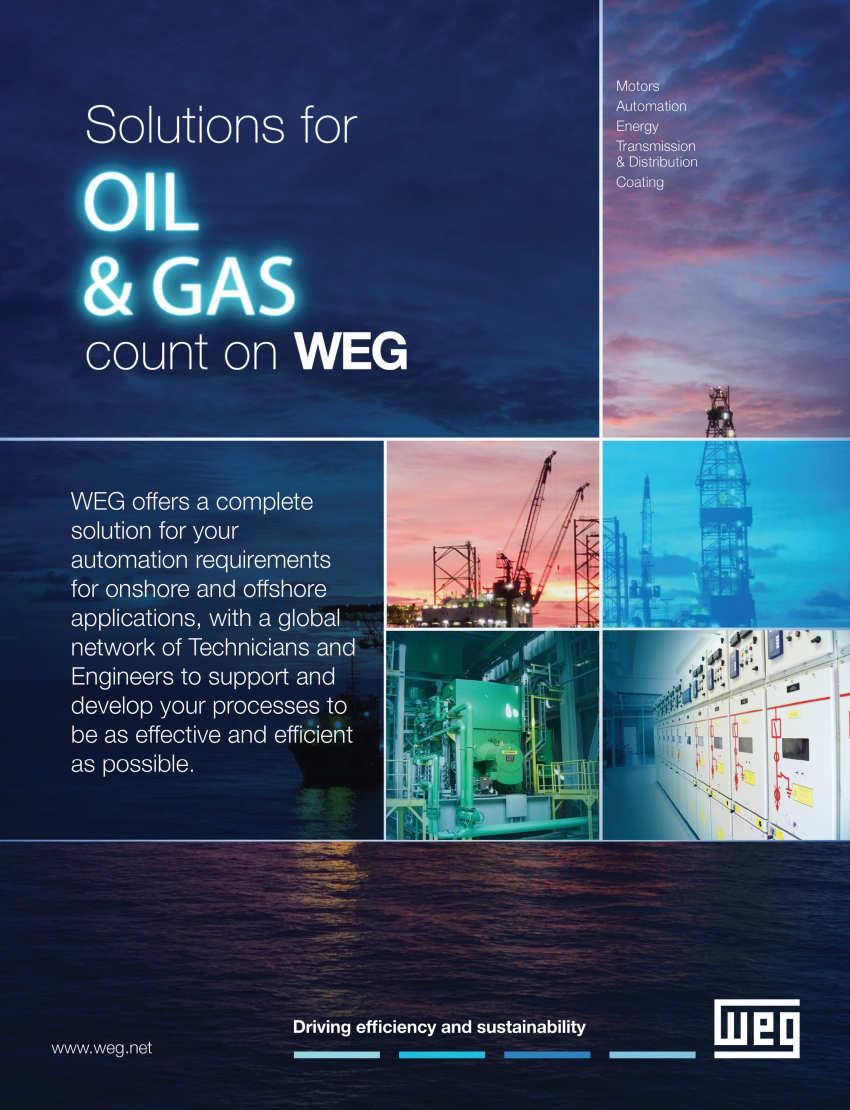
to industrial workplaces, helping to reduce the risk of injury, boost productivity and bring proactive safety management to a new level. We’re responding to a direct need in the market, giving safety managers higher performing technology to access reliable, actionable data at their fingertips.”
In January 2023, Blackline Safety announced its largest ever deployment in the Middle East for one of the world’s largest energy and petrochemical companies.
The company is purchasing G7c cellular wearables and G7 EXO area monitoring devices to protect their workers at various sites across the Middle East. Blackline’s all-inone solution for lone worker and gas detection improves frontline worker safety and optimises operations by providing access to real-time information.

“This record-breaking deployment demonstrates the return on investment we are receiving as a result of our marketing and sales efforts in the Middle East. A growing number of global companies are investing in Blackline’s connected safety solutions to protect their workers while on the job,” said Sean Stinson, chief growth officer, Blackline Safety.
Dräger Marine & Offshore
Elsewhere, the Marine & Offshore subsidiary of Dräger recently launched a new mobile gas
detector, the X-am 2800, expanding its extensive safety and gas portfolio. The device offers simultaneous measurement of up to four different gases, for application in confined spaces to safeguard employees working in areas at risk of oxygen depletion, explosive atmospheres, or those where toxic substances may be present. Tested in line with International Protection Rating Class 68, the X-am 2800 is designed to withstand the harshest conditions.
Euan McIntosh, Dräger Marine & Offshore marketing manager, said, “The North Sea is home to some of the most difficult working conditions in the offshore industry, and personnel need peace of mind when working in such situations. We have listened to the industry and understand the problems faced. The X-am 2800 is one of the few pieces of kit on the market that will be able to withstand the wet and windy challenges faced in the North Sea and is suitable for a range of uses
New gas detection handbook issued
MSA SAFETY HAS issued its ninth edition of the MSA Gas Detection Handbook. This 155-page detailed handbook contains a basic glossary of essential gas detection terms and abbreviations along with a summary of key principles in combustible and toxic gas monitoring. Additionally, it provides real world reference data –including physical properties and exposure limits for the most commonly monitored gases found in industrial and various other environments.
Readers will find helpful the handbook’s comparison of today’s most widely-used gas detection technologies, which can help them better understand the advantages of the various gas sensing technologies and how they perform in multiple plant environments. The handbook also includes a table indicating the gas hazards common
to specific applications within major industries. In addition, the handbook’s summary of key gas detection instrumentation approvals information, including hazardous locations classification, is essential in order to comply with safety standards and regulations.
MSA’s exclusive Sensor Placement Guide in the handbook provides important factors to take into consideration when determining optimum gas sensor placement. Understanding sensor placement is critical to effective gas leak monitoring and helps avoid failures to alarm during actual gas leaks as well as avoiding false alarms that cause unnecessary plant shutdowns.
The section on Combustible Atmospheres explains the basic conditions under which a flame can appear, including
across the maritime and offshore industry.”
The X-am 2800 has been independently drop-tested to withstand a fall of more than two metres on concrete: an essential metric for a wearable solution. The unit comes as standard with integrated Bluetooth connectivity, meaning live gas readings and alerts can be transferred in real-time to Dräger’s Gas Detection Connect cloud solution, providing users with access to critical data remotely.
MSA Safety
Adding to the range of wearable options on the market, MSA Safety earlier in 2022 unveiled the ALTAIR io 4 wearable. Equipped with instant cellular connectivity, the connected wearable enables operators to access cross-worksite visibility from day one. Simplifying maintenance, the portable detector can sense when bump test or calibration is required, and will immediately run the tests as appropriate, when docked. n
the source of the fuel gas, the oxygen level required to burn, and the heat source of ignition. Examples of combustible gas heat and ignition sources are provided such as burners, welding torches, sparks from electrical switching, and more.
In addition to combustible and toxic gases, oxygen deficiency is a common plant hazard that results in many accidents. The handbook explains the difference between oxygen deficient areas which contain too little oxygen (less than 19.5% oxygen by volume) that affects breathing and oxygen enrichment (more than 25% oxygen by volume) that result in an increased risk of explosion.
To obtain a copy, go to https://us.msasafety.com/fgfd-gasdetection-handbook
Dräger’s X-am 2800 mobile gas detector is designed to withstand the harshest conditions.
Gas Detection 22 oilreview.me Issue 1 2023
In January 2023, Blackline Safety announced its largest ever deployment in the Middle East.”
Image Credit : Dräger Marine & Offshore

SAFEEN Group set for regional expansion
SAFEEN GROUP, PART of AD Ports Group, is an industry leader in the provision of world-class integrated marine services, offering advanced marine services, merchant shipping, transshipment, offshore and subsea solutions for customers across the region and beyond. As such, it is the largest diversified provider of maritime services in the region and continues to expand its fleet of vessels as part of an ambitious growth plan to build capacity and enhance its portfolio of services.
Portner sees “fantastic prospects” overall for the Middle East, although the dynamics differ from sector to sector.
“The shipping industry is a bit more globally driven, but when we come to the offshore sector, the prospects are more Middle East centric,” he comments.
“We see amazing prospects in the pipeline, after some sluggishness in the market, whether it be with ADNOC, Aramco or QatarEnergy. A lot of mega projects are coming to fruition at the same time, from around 2023-2025, so we see a clear demand trend.
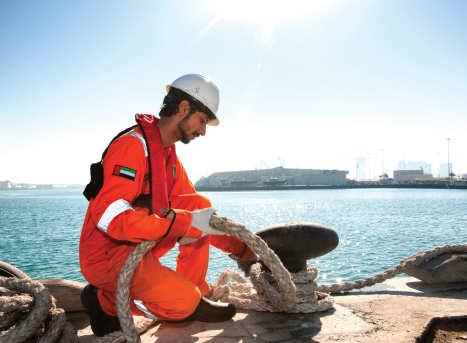
“At the same time, when we look at offshore, there is a clear decrease in the supply of available assets, creating a ‘scissor effect’. Before, we had more supply than demand; now it’s the opposite.
“We have been very active this year in purchasing assets in all sectors – in shipping, marine services, and especially now in offshore. This is driven by the prospects in the Middle East and the need to have access to assets in the region, because there will be a shortage. Clients are knocking on everyone’s door to secure the right assets, and we’ve been purchasing a multitude of these –offshore vessels, subsea vessels, barges –and we will continue doing that.”
One of its most recent acquisitions has been the ‘SAFEEN Surveyor’, a subsea multipurpose vessel, which will support subsea inspection, repair, and maintenance works.
Attractive value proposition
SAFEEN Group prides itself on its
commitment to excellence and adherence to the highest operational standards, as well as providing efficient and cost-efficient services.
“Cost efficiency and service quality go hand in hand, driven by three or four factors,” says Portner.
“One is definitely scale; with scale you gain efficiency on the back of the overheads. Second, the right acquisition price. We started our acquisitions when prices were lower, and we’re continuing now that prices have gone up, but I still believe our cost structure, compared to others who have historically
purchased at much higher prices, will create competitiveness.
“In terms of operational expenditure, I would highlight our integrated business model. It’s beneficial for us, and for the client. Beneficial for the client, because they have one entity who is accountable, reducing risk of interface losses and ensuring a certain quality, because that one entity is looking at the whole package. It’s also less bother for the client, as they can deal with a smaller team rather than having to manage several individuals.
"From our side, if we have a full end-to end package, we are responsible to optimise. It is difficult to do that if items are split, as you lose control over the full supply chain. For example, we can make sure that the arrival of a vessel can be integrated with our lifting operations. There are a number of factors which we can play with and optimise, so we
SAFEEN Group is an industry leader in the provision of world-class integrated marine services.
Friedrich Portner, chief commercial officer, Maritime Cluster, AD Ports Group, discusses growth prospects and the company’s drive for optimisation.
Marine Services 24 oilreview.me Issue 1 2023
We have been very active this year in purchasing assets in all sectors.”
Image Credit : AD Ports Group
have fewer losses as well. No waiting time, no wastage. This creates cost savings, which we can pass on to the client to a certain extent as well.
“Last but not least, in terms of our cost competitiveness, we’ve been very good at finding partners in different geographies. This joint venture/ partnership/ collaboration model helps us to better understand the markets and deliver better quality to the client.
“All of these elements are good on their own, but together they create a value proposition which is very attractive for both parties. We can optimise, and the client can optimise.”
The role of digital Digital technology has a key role to play in the drive for optimisation.

“Management sees digital technology as one of its highest priorities, as illustrated by the fact that we have in AD Ports Group a dedicated digital division to help us augment,” explains Portner. “Just as we are optimising service delivery, this division is looking at how it can help us optimise the supply chain, creating dedicated and specialised tools for us. We have an in-house ability to develop our own intellectual property and also to integrate it with third party intellectual property, coupled with our knowledge of the industry to enhance and deploy it.
“So, it creates digital momentum, and, importantly, we’ve just embarked on a new digital strategy for maritime, which shows how important it is in our day-to-day mindset. The aim of digital is two-fold: first, how can we optimise and create visibility and then take the right decisions. Secondly, how is this reflected in better efficiencies and better processes. We are trying to go one level above the digitalisation of day-to-day operations, basically creating or visualising the data we know, knowing what we know, to be able to curate this information and deduce from it the right management decisions.”
This has a positive impact on the
environment too, he adds, as facilities can be optimised to work as sustainably as possible.
“By doing this we can make the right decisions for sustainability and for the utilisation of the assets, in multiple dimensions.” n
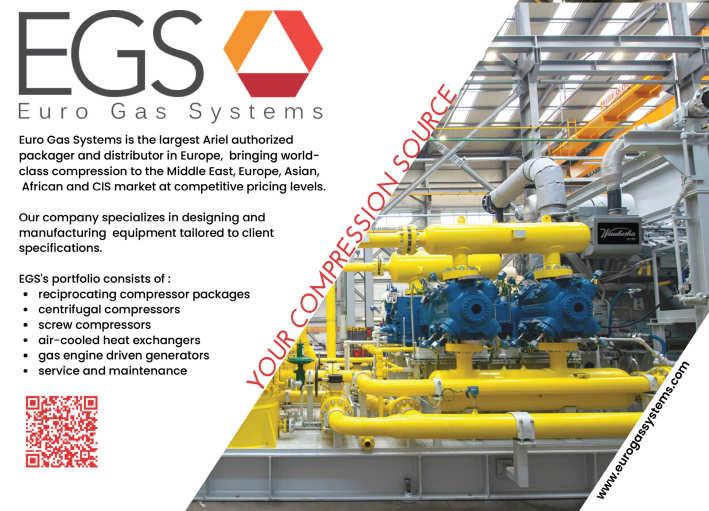
Management
sees
digital technology as one of its highest priorities.”
Marine Services
Friedrich Portner, chief commercial officer, Maritime Cluster, AD Ports Group.
Issue 1 2023 oilreview.me 25
Image Credit : AD Ports Group
Advancing inclusive and sustainable energy
AS WE ENTER the Year of the Rabbit, the urgent need to ‘stop rabbiting on’ and ‘hop to it’ is only going to increase. Achieving a great leap forward in action on energy-climatesecurity challenges involves big (fundamental) changes. Yet success depends on hundreds and thousands of smaller steps.
And like the wisest of rabbits, we must quickly make sense of the winds of change and keep recharging our batteries as we adapt to circumstances beyond our control. Co-creation of our destiny is key.
Our World Energy Council focus remains on facilitating transformational breakthroughs in securing more energy for sustainable development and averting a planetary crisis. The energy space is going to get much messier – and we must learn to get better at moving forward clean and just energy developments at pace and scale.
Recently I attended Abu Dhabi Sustainability Week (ADSW). H.E. Dr Sultan Al Jaber’s presidency of COP28 was announced, triggering a flurry of responses which, yet again, indicate that the risk of extreme polarisation in climate-energy leadership has not faded:
• Purist perspectives – ‘conflict of interests,’ calls for resignations, reflecting ‘zero fossil fuels’ and rejecting ‘net zero’ and ‘net negative’ plans; as opposed to
• A pragmatic stance – the need for ‘all levers,’ opportunities to scale renewables with other clean energy solutions, demand for clean and just/inclusive implementation.
Based on my years of experience in leading
the OECD’s strategic foresight activities, the UAE is one of a handful of governments worldwide that has invested serious efforts in mainstreaming strategic foresight and futures design practices in national policy. The World Energy Council is committed to working closely with visionary leaders, such as HE Dr Sultan, and helping pull together an inclusive and impactful climate-energy convening at COP28.
From my participation in high-level discussions at ADSW, I noted with excitement:
• There is no need to wait. The global stock-take will reveal the world is well off track from achieving Paris Agreement commitments by 2030. And preventing planetary crisis involves so much more.
• All levers must be used to maximise clean energy benefits whilst minimising greenhouse emissions. Opportunities include targeting energy-related methane emissions and directing attention to more global and ultra-local public-private partnerships, so that diverse communities at all levels of society can engage in and benefit from the future making process.
• The bigger role of finance should not be neglected in progressing the opportunity of financial innovation. Redirecting investment flows to support a broad landscape of technological innovation (CCS, green hydrogen, storage) is urgent. It’s also important to ensure financial innovation really enables inclusive and sustainable energy developments.
• Wider bridges must be built to overcome Global North versus Global South divides.
It is urgent to progress a new deal on loss and damage AND important to use more energy to create real opportunities for billions of better lives.
Candid co-operation in a fragmenting world
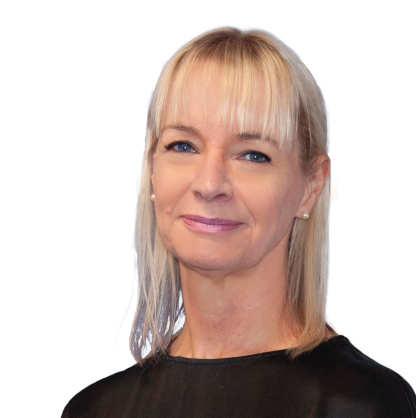
The positive ‘can do’ spirit of ADSW contrasts with the dismal outlook of global economic recession, prospects of new trade wars and further increases in global environmental risk.
We have grown weary with the calls for cooperation from mountain-top summits –instead, we are busy doing it! Our diverse members in more than 100 countries are planting new seeds in fertile valleys where communities live and work to grow a more shared, sustainable, and resilient energy future.
There is no ‘one-size-fits-all' solution, big lever, nor silver-green technology bullet.
A promising but messy pattern of inter-, intra-, and sub-regional co-operations is emerging. For example, at the annual meeting of the World Energy Council in Estonia last week, the cooperative leadership dialogue focused on the ‘how to’ and ‘who with’ of effective regional co-operation across the Baltics and between Baltic-Nordic energy-climate interest.
Other new regional co-operations to look out for include ME-SEA (Middle EastSoutheast Asia) and LA-NWE (Latin AmericaNorthwest Europe). n
You can read the entire blog and more on the World Energy Council website at https://www.worldenergy.org/news-views
Dr. Angela Wilkinson, secretary general and CEO, World Energy Council.
Dr. Angela Wilkinson, secretary general and CEO, World Energy Council, discusses what we might we learn in the Chinese Year of the Rabbit to advance inclusive and sustainable energy developments.
Energy Transition 26 oilreview.me Issue 1 2023
Image Credit: World Energy Council
Tackling climate change with new technologies

To what extent is tackling climate change a focus for the Middle East? And what progress has the region made so far in investing in, facilitating and developing climate technologies?
A number of countries in the region have taken major steps to reach their climate change goals, with a focus on pioneering technologies. A few days prior to COP27, Saudi Aramco unveiled a US$1.5bn sustainability fund that would invest in the technology required to facilitate the transition to green energy. The fund will rank among the biggest venture capital funds with a sustainability focus in the world. The UAE also signed a US$100bn strategic agreement with the USA in clean energy projects, focusing on investing in reliable and responsible supply chains and encouraging investment in green
mining. This was a significant development as the country prepares to host COP28 in 2023. Other significant announcements in the region included the UAE-based bank Mashreq's plan to increase its sustainable financing to US$30nm by 2030 and the Arab Coordination Group's promise to provide at least US$24bn
in climate finance by 2030 alongside the OPEC Fund for International Development, which coordinates climate finance.
GCC countries have been catching up to emerging and developed nations in renewable energies investments at an incredibly fast rate. In our recently issued report, titled ‘Tackling climate change through technology: A global leadership role for the Middle East’, we’ve found that US$6bn has been invested in climate tech since 2013 by 12 Middle Eastern countries, and US$1.6bn of that was invested in the first half of 2022 only.
With targeted investment, the Middle East will be able to assume global leadership in a number of climate tech domains where it now enjoys a competitive advantage.
There are a number of reasons for this impressive growth rate in renewable energy
Dr Yahya Anouti, PwC Middle East ESG leader, discusses the potential for the Middle East to assume a leadership role in climate technologies.
With targeted investment, the Middle East will be able to assume global leadership in a number of climate tech domains.”
Decarbonisation Issue 1 2023 oilreview.me 27
The Middle East has a number of green competitive advantages.
Image Credit : Adobe Stock
investment witnessed in the region. Firstly, Middle Eastern nations can take advantage of their natural resources by building sustainable hydrogen and solar power plants, thanks to differentiated availability of land. The cost of producing solar-based electricity, and green hydrogen in the Gulf is significantly competitive due to the fact that the region enjoys some of the highest solar voltaic output in the world. Both the UAE and Saudi Arabia have made solar energy cost competitive as a result, and renewables have become an important regional investment focus.
At the same time, sovereign wealth funds are in a position to support a significant push into climate tech innovation locally as well as globally, at a time when the global economy is in a phase of slowing growth. Add to the aforementioned, the fact that the region is investing largely in new industrial zones that are set to be sustainable and circular. One final point is related to the capabilities. The region can easily pivot its capabilities in the chemicals sector towards the hydrogen economy, and direct its youth towards STEM education in related fields.
Despite the plummeting of the overall venture funding for climate tech start-ups by US$52bn over the first three quarters of 2022, our analysis reveals an increasing desire for investment in the Middle East. However, broader tech investment trends in the Middle East also follow the global trend: after sharp increases in overall tech funding over the past few years that continued into the first half of 2022, the investment momentum slowed in the second half of the year.
What areas or sectors do you think offer the most promising opportunities for the region to take a leading role in developing innovative solutions?
Given the above-mentioned green competitive advantages and the existential challenges, the region has the right to win in six climate tech areas:
• Green fuels: green hydrogen and synthetic fuels

• Green industries (e.g. heavy industries –steel, aluminum, titanium; and consumercentric products – sustainable fashion)
• Climate resilient agri tech (precision fermentation)
• Decarbonising the built environment with circular economy (e.g., plastic recycling, construction waste recycling, energy recovery from waste)
• Direct carbon capture from air
• Nature-based solutions for arid environment (e.g., mangroves plantation, high carbon capture trees with low water intensity, blue economy concept on the Red Sea side).
To win, the region has to move fast and in an agile way, noting that we have a unique window of opportunity to attract foreign direct investment looking to walk the ESG talk.
At PwC, we believe that Environmental, Social and Governance (ESG) imperatives can accelerate the massive and fast transformation of our region. Through the strategic role the region plays in the energy transition, pioneering hydrogen and circular economies, developing sustainable destinations, localising supply chains, generating employment, expanding social inclusion and good governance, ESG can both drive the transformation and create opportunities to develop world-leading, competitive advantage.
What factors will need to be leveraged for the region to successfully play a leadership role in climate tech?
Funding climate tech in the MENA is one part of the equation – the easy one. Success requires a holistic and mission-oriented or moonshot approach that hinges on the following:
Connect the dots between sovereign wealth funds, government programmes, and national champion plans –essentially launching a climate-tech mission. Connecting the dots also goes beyond the region, to include deeper partnerships with countries that share common goals.
De-risk through longitudinal collaborations. It will be important to create off-take markets for the local innovations, by connecting green product end-consumers such as airlines or shipping companies for synthetic fuels with the green fuel supplier, supply-chain innovators including electrolyser manufacturers, and carbon feedstock providers, where relevant.
Make climate tech a major R&D priority and channel long-term and “patient” funding that brings in innovators and researchers around missions. In addition, the region should design new educational programmes and dedicate applied institutes related to climate technologies, such as nature-based engineering and the hydrogen economy.
Pivot existing capabilities. GCC countries could leverage their expertise as global leaders in oil and gas to develop other capital-intensive, and geologically complex green energies, including geothermal energy and carbon air capture and sequestration. The region’s capabilities and knowhow in petrochemicals could likewise be critical to develop synthetic fuel production and the hydrogen economy. Ammonia subsidiaries or business units can become core growth platforms.
Create an enabling ecosystem. Establishing regulatory “sandboxes” in which new approaches could be tried and tested in a careful but encouraging environment will
help with their development. Better data about climate investments, including reporting requirements for companies, could already help track how and where funds are flowing, and thereby help set clearer priorities.
Galvanise the younger generation. Climate change is an inter-generational problem, and the Middle East, with its young populations, has the potential to galvanise the younger generation into action, providing new purpose and new vision for the region. That will require a focus on education, to ensure that climate science and its ramifications become part of the core curriculum. Employers can also help unleash youthful energy. n
The region could take a leading role in areas such as plastics recycling and circular economy.
Decarbonisation 28 oilreview.me Issue 1 2023
GCC countries could leverage their expertise as global leaders in oil and gas to develop other capital-intensive and geologically complex clean energies.”
Image credit: Adobe Stock
Global upstream: what to watch in 2023
Wood Mackenzie, a Verisk business, has released its Global upstream: 5 things to look for in 2023 reports.
UPSTREAM OIL AND gas companies made big strides in 2022, restoring confidence and repairing balance sheets. But the challenges the industry faces will compound in 2023, says Wood Mackenzie. Key themes to watch for include navigating windfall taxes and inflation, restrained investment growth, cost inflation, decarbohnisation and changing business models for gas.
Windfalls and incentives
Country risk has risen toward the top of the pile of investor considerations. If prices move higher, more countries will take action in the form of price caps or windfall taxes. Operators will have to reassess current and new opportunities, even in countries previously thought to be low-risk.
“We will see many different approaches, from windfall taxes to relieve pressure on public finances, to incentives which accelerate oil and gas potential,” said Fraser McKay, head of Upstream Analysis at Wood Mackenzie. “Many of these actions will begin to reflect the energy transition aspirations of host governments. We advocate smart policies which provide both fairness and predictability, regardless of the prevailing price.”
Restrained investment growth
Industry cash flow will fall 9% to US$1.3 trillion in 2023, while reinvestment rates (investment divided by operating cash flow) will rebound to 28%, up from an all-time low of 24% in 2022. Development spending will increase as well, up at least 10% to between US$460bn and US$480bn.
McKay commented, “Investment needs to rise further in 2023 and subsequent years if supply shortages are to be avoided. But not by as much or for as long as many market observers think. And with corporate deleveraging largely complete, there is room for both incremental
reinvestment and continued shareholder distributions. Who increases spend, where and by how much will be a much debated topic in 2023.”
Decarbonisation at the core of Upstream 2.0
Governments and NOCs in the main producing countries will try to marry lowcarbon credentials with increasing upstream investment in 2023. IOCs looking to be part of Upstream 2.0 will need to demonstrate and disclose further emissions reductions.
McKay stated, “Regulations will compel companies to invest in measurement, monitoring and mitigation. Those that have already tackled the low hanging fruit will need to dig deeper – electrification and grid connection where it’s possible, dedicated renewables where it’s not. By the end of 2023, it will be extremely hard for mainstream operators to sanction projects without emissions mitigation plans.”
Cost inflation will constrain the impact of spend increases, and supply chain bottlenecks and inefficiencies will threaten the hard-fought gains made through previous downturns. Around half the global increase in spend will be consumed by widening supply chain margins.
Near term investment trends
Gas business models will start to change
The European gas crisis triggered price spreads that will make upstream operators reassess their gas business models. Nearterm investment will focus on raising domestic
Global upstream reinvestment rates
Investment needs to rise further in 2023 and subsequent years if supply shortages are to be avoided.”
Continued cost inflation Economically viable Justifies for development Approved for development lower 48 On production 600 500 400 300 200 100 0 US$ billion (2023 terms) Global upstream reinvetment rate 2018 2019 2020 2021 2022 2023 140% 120% 100% 80% 60% 40% 20% 0% 2012 2013 2014 2015 2016 2017 2018 2019 2020 2021 2022 2023 Upstream Image Credit : Wood Mackenzie Issue 1 2023 oilreview.me 29
European production and new development concepts to unlock stranded gas.

“We won’t see the industry spending more on gas than oil this year, but it’s clear that gas remains investible and will play an important role for upstream companies moving forward,” said McKay. “This year, operators will focus on making gas project returns more competitive with oil, while evaluating CCUS for high CO2 content fields and even blue hydrogen concepts.”
Middle East and North Africa upstream: five things to look for in 2023
Buoyed by high prices and swelling NOC coffers, investment will ramp up in 2023, Wood Mackenzie says. Gas and LNG will
dominate development -
Spending will be heavily skewed to gas and LNG developments. Gas will also be emphasised in exploration throughout the region as governments capitalise on high prices and the longerterm shift away from Europe’s dependency on Russia. Capex will exceed US$100bn, up 7% on 2022 levels. Up to 15 major projects will reach FID next year, with the majority focused on gas and LNG. The Middle East will lead with 14 projects, continuing its solid growth trajectory backed by record cash flows, and a resurgence in demand. QatarEnergy is expected to sanction North Field South, its third major LNG expansion project. In UAE, ADNOC may approve the 9.6 mmtpa Fujairah LNG project and Hail & Ghasha, the US$15bn offshore ultra-sour gas development, is expected to get the goahead. There may also be further LNG growth in Oman.
After a year of political stasis, Iraq’s energy sector is ready for actionAfter a ‘lost year’ following the October 2021 election, Iraq has formed a new government led by the Iran-aligned Prime Minister, Mohammed Shia al-Sudani. With all major legislation and investment decisions put on hold during the tenure of the previous caretaker government there is a growing list of priorities. With strong oil export revenues and a new oil minister, Hayyan Abdul Ghani, Iraq is now able to address its critical energy issues. Investment in long-starved gas and power and critical oil expansion projects can finally take off. The longawaited 400 mmcfd Basrah NGL plant will start up, and the Mansuriyah and Akkas gas fields should be ready to proceed. Licences could be issued for more gas projects.
Focused portfolio rationalisation will increase asset churn - M&A activity declined in 2022, both in deal count (six versus nine) and deal spend (US$2.9 bn lower). A steadier oil price could better align buyer and seller expectations in 2023. Portfolio rationalisation will feed the pipeline with the Majors shedding marginal, peripheral assets. Generally strong deleveraging across the industry in 2022 should free up capital for selective M&A. Independents and Asian NOC will be the likely buyers. Value traded will be small. GCC countries will double-down on low carbon and sustainable development - Carbon reduction and sustainability will be dominant themes throughout the year. Five out of six GCC countries have signed up to net zero emissions: Saudi Arabia, UAE, Oman, Bahrain and Kuwait. Furthermore, with UAE hosting COP28 in November 2023, the Middle East will take centre stage. A Middle East vision for sustainable energy supply is continued hydrocarbon development with a big focus on low carbon emissions. Several key upstream measures will be pursued aggressively to support the vision.
Exploration and licensing: Majors' gas probes will dominate activity - Offshore exploration will ramp up in the Eastern Mediterranean, with the potential to alter the region’s gas dynamics. And the number of bid rounds could increase as governments capitalise on high prices and a longer-term shift away from Russian dependency.
“We anticipate big strides in GCC countries eliminating methane leakages and expanding carbon capture and storage,” the report says. “In CCS Saudi Arabia, UAE, and Qatar have taken the lead with 5.1 mmtpa of operational CO2 capture projects. We expect rapid progress towards investment decisions on several new projects.” n
You can read the entire report and Wood Mackenzie’s regional upstream reports on its Upstream Content Hub at https://www.woodmac.com/news/opinion/ups tream-oil-and-gas-2023-outlook/#form
Spending in MENA will be heavily skewed to gas and LNG developments.
Upstream 30 oilreview.me Issue 1 2023
We anticipate big strides in GCC countries eliminating methane leakages and expanding carbon capture and storage.”
Image Credit : Adobe Stock
NESR piecing together ‘multi-circularity’ in oil & gas
How is business looking for NESR in 2023 and how do you view market prospects?
Despite fears of a recession, the macro and commodity price environment for oil & gas remains at a multi-decade high, mainly due tight supply dynamics underpinned by multiple underinvestment cycles, as well as capital discipline in regions such as North America. Given this strong and stable outlook, NESR is in the midst of a robust activity inflection in 2023, and expects MENA upstream activity to show strong growth through at least the middle of the decade.
How are you looking to develop your business this year? Are there any particular contracts or initiatives you would like to highlight?
Over the past five years since its inception, NESR has continuously led the market in terms of investment in equipment, technology and people, in anticipation of the historic activity upcycle currently underway in the MENA region. In addition to sector-leading growth across wellestablished Production Services and Drilling & Evaluation product lines, NESR is well-
positioned to achieve outsized growth in technology-rich segments such as Wireline, Directional Drilling, and RSS/LWD over the coming years. Contract wins such as the 10-year Wireline contract in Saudi, in addition to a bevy of Directional Drilling contract wins in the GCC, underpin this positive outlook. Moreover, the impending opening of the NESR Oilfield Research Facility (NORI) in Saudi’s Dharan Techno Valley, will support this and also business development across the decarbonisationfocused ESG Impact segment offering.
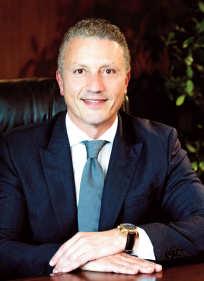
Are there any particular technology trends or developments that are impacting your business?
With the pivotal and highly successful COP27 in Egypt, and with the highlyanticipated COP28 in UAE, intense focus on industry decarbonisation is the overwhelming driver of a paradigm shift in the industry. As such, NESR is leveraging its unmatched ESG Impact segment portfolio to streamline the importation of revolutionary technologies & workflows to help customers enhance resource stewardship and achieve “Multi-Circularity” in oil & gas. NESR offerings such as Flare-
to-Forest TM focus on both flare gas-topower and also produced water desalination & mineral recovery, to completely transform the industry from a consumer of precious resources (power, water, salt) to an abundant supplier of such byproducts to other industries.
What will be your focus at MEOS/GEO, and what will you be showcasing?
NESR’s focus at MEOS will be to meet with customer, governmental, and community stakeholders alike to discuss the potential for multiple circular economies that can be achieved with outside-the-box technology adoption across flare capture, water treatment & mineral recovery, emissions detection, and heat & geothermal. NESR will showcase key technologies across all of these ESG Impact focus areas, as well as those innovations within Directional Drilling & RSS/LWD that will help drive the next leg of activity increase within MENA upstream.
How do you hope to benefit from participating at the show?
NESR’s growth strategy leans heavily into R&D and technology partnerships, and a critical facet of this strategy are the learnings and feedback provided directly from customers. NESR is in the business of solving customer challenges, so a key benefit of the MEOS show will be to interact with both customers that are bringing diverse challenges to the table, as well as with technology providers that could be additive to the leading-edge solutions that NESR has developed to address those challenge s. n
NESR has continuously led the market in terms of investment in equipment, technology and people.”
Technology Issue 1 2023 oilreview.me 31
NESR will showcase key technologies across all of these ESG Impact sectors.”
CEO Sherif Foda discusses how amidst the activity upcycle that is accelerating across the MENA region, NESR is focused on outside-the-box technology development to establish multiple circular economies in upstream oil & gas.
Sherif Foda, CEO, NESR.
Image Credit : NESR
Leading the way in seismic data processing & imaging

Can you give some brief background about your company and how your HPC solutions are used in the oil and gas sector?
Put simply, DUG is an innovative technology provider for the global resource sector. We founded DUG in 2003 to capitalise on an idea for a Bayesian decision support system. Our aim was to help companies process and image their large seismic datasets, presenting the results in ways that were easier to understand and leverage.
We have always had a strong focus on R&D – both in applied geoscience technology and high performance computing (HPC), two areas which go hand-in-hand in our business. We also recognised that we needed our own software to stay competitive and to continue innovating. We have grown a large, talented R&D team who work on all aspects of our technology offerings, which consist of HPC as-a-service, geoscience and data services, and software – offered to our clients directly or tailored to suit their needs via our DUG HPC Cloud platform.
Can you tell us about DUG Wave and how this technology works to simplify the seismic imaging process?
We started building DUG Wave in 2016 with the goal of reducing project turnaround time and improving results through a combination of the more advanced physics of full waveform inversion (FWI) and the horsepower of HPC. Since 2018 we have successfully delivered high-frequency FWI solutions, and in 2021 we introduced our revolutionary multiparameter FWI imaging technology.
Conventional seismic workflows contain many time-consuming serial steps. We
wanted to do this more efficiently. Our innovative approach provides reflectivity images for both structural and quantitative interpretation, without the need for those serial steps. It enables full-wavefield model building and least-squares imaging using fielddata input, simultaneously handling deghosting, demultiple and designature. It is literally the entire conventional workflow in a single process! It also elegantly handles regularisation, attenuation and anisotropy. The angle-dependent outputs allow not only conventional interpretation but also AVA analysis as well. I really can’t overstate how excited we are about this technology as a complete and superior solution for subsurface characterisation.
Can you tell us about your plans for MEOS/GEO and what you will be showcasing?
I am very excited that DUG will be exhibiting at MEOS/GEO. While we process all types of seismic data, high-density land has been a
focal point for us in recent times. Our Houston office is now the biggest land data processing centre in North America, and indeed, DUG is now the third largest proprietary seismic data processing company in the world. We design, own, and operate a network of some of the largest and greenest supercomputing installations on earth which support this effort.
While our team at MEOS/GEO will be available to discuss all aspects of our technology offerings, we will certainly be focusing on our onshore processing and imaging capabilities. I believe the combination of our deblending and multi-parameter FWI imaging can provide significant benefits, both technical and commercial.
DUG Insight is our flagship software product for seismic interpretation. It is modern, intuitive and interactive with a complete functionality offering for interpretation, visualisation, time processing, depth imaging and FWI. We look forward to showcasing both our software and HPC as-aservice offerings too. n
Dr. Matthew Lamont, managing director and founder of DUG Technology.
Dr. Matthew Lamont, managing director and founder of DUG Technology outlines the company’s seismic data processing and interpretation technologies.
Seismic Data 32 oilreview.me Issue 1 2023
DUG is now the third largest proprietary seismic data processing company in the world.”
Image Credit : DUG Technology
The state of digital transformation in energy and utilities
What are the main drivers and benefits for digital transformation as far as energy companies are concerned?
IFS conducted a survey in mid-2022 to understand the state of digital transformation in the energy and utilities sectors with 602 senior decision-makers in the UK, North America, the Nordics, Middle East, Japan, Australia, and France. In general, these sectors are looking to have tighter technology integration and better project management. One of the main findings was that they want to use enterprise software systems such as enterprise asset management (EAM), enterprise resource planning (ERP) and mobile workforce management (MWM) to achieve tighter integration and collaboration across different functions.
As technology drivers, Machine Learning (ML) and Artificial Intelligence (AI) are being implemented to optimise operations and for higher revenues while reducing losses. IoT is being used by the industry for efficiency, performance and more importantly for safety. Similarly, Cloud-based technology is being strategically placed within digital transformation for flexibility as well as data processing and storage, as well as to provide remote access and real-time data.
Sustainability is another key driver for the adoption of advanced enterprise software. With 90% of the world’s GDP now covered by net zero commitments, a plethora of ESG compliance and regulations, soaring global energy prices, the skills gap and more importantly increased consumer accountability are paving the way for industries across all sectors to reassess their ESG efforts and make heavier investments to attain net zero status.
What are the main challenges to digital transformation efforts?
Digital transformation is definitely helping companies across systems and processes; however, it comes with its own set of challenges such as security risk, understanding the skills requirements to ensure a smoother transformation process, while also dealing with employee sensitivity and job loss perceptions. In addition, some
organisations have difficulty accessing and analysing critical data while also dealing with managing the balance between advanced and legacy systems.
The IFS research revealed that there are still significant barriers to technology adoption, especially around the inability to define and measure the ROI of enterprise software systems. 79% of respondents specified that it was important to them for enterprise software to have the embedded capability to set and measure critical KPIs. Being able to measure value quickly and accurately is clearly a vital requirement for many senior decision-makers right across oil, gas, renewables, and the utilities.
Other barriers included a lack of clarity around the resources and skills required and a poor use of business cases which can make adoption of digitalisation look complex and too expensive to implement.
Where do companies hope to gain the biggest impact from digitalisation?
One of the most striking investments in digital transformation by the energy sector is to achieve their goals to become net zero companies by 2050 while making significant progress to cut emissions by 2030. The oil and gas sector is consciously making changes to help boost efficiency and increase safety. And, for better impact on their revenues, they are using advanced systems to analyse their assets that help them take preventive measures.
The availability of granular data merged with advanced analytics helps them assess customer experiences and benefits, provides them with a springboard to develop new products and services and creates opportunities for new revenue streams. Simultaneously the adoption of Advanced Metering Infrastructure (AMI) is likely to grow exponentially, and it encourages these sectors to delve deeper into their security strategies and device management.
What technologies are attracting the most interest in terms of digitalisation? Consumer demands are changing, and
oil and gas and the utilities sectors are making efforts to make some critical changes to suit these demands. Additionally, the requirement to comply with and adhere to sustainability requirements is another area where these organisations are implementing suitable technologies to raise the momentum of their digitalisation and improve their business outcomes. These include, AI and ML, Cloud computing, IoT and automation.
Are there any noteworthy findings from your survey related to participants in the Middle East?
Significant research findings for the Middle East were:
• More than 70% of net respondents in the Middle East said that they are focused on emerging technologies such as Data Analytics, AI, Augmented Reality, IoT, Virtual Assistants and Chatbots.
• More than 55% of respondents were looking for a composable enterprise platform that will support their entire digital transformation journey.
• 36% agreed on tighter integration and collaboration and 30% identified better project management as the top business drivers for the adoption of enterprise software systems (such as EAM and ERP, MWM).
• 48% would invest in more energy efficient assets and infrastructure and 41% would engage with customers and suppliers to meet their sustainability goals.
• When considering advanced asset management solutions, 47% said it was very important to ensure improved asset maintenance and monitoring, 37% said it was very important for improving supply chain management and reducing inventory costs, 37% said it was important for mobility, 44% for scheduling and despatch, and 46% said it was important for the support it provides to compatible units.
• 37% said that the main driver for automating customer experiences was to help improve customer relations and experiences. n
Carol Johnston, VP Energy, Utilities and Resources at IFS, discusses the findings of the company’s survey on the state of digital transformation in the energy and utilities sectors.
Digitalisation Issue 1 2023 oilreview.me 33
Advanced connectivity for oil and gas
What is a private cellular network, and what is the difference between a private and public network?
A private cellular network is the connectivity solution for enterprise workers and devices that is designed solely based on their service quality requirements. In principle, private and public networks have similar infrastructure. Whereas a public network is designed by a mobile network operator considering the needs of the population, and the connectivity resources are used by consumer and business customers together. If an enterprise intends to use public network connectivity, it is unlikely to talk about the guaranteed service quality at any time.
What advantages does 5G offer for oil/gas/refinery operators, compared to other conventional technologies?
Oil, gas and refinery fields are located in big outdoor environments where advanced cellular technologies such as 4G (LTE) and 5G are the best solutions to cope with the coverage, capacity and performance requirements of the operators. Private cellular networks, especially
private 5G, complemented with the low earth orbit (LOE) in such environments can enable oil and gas companies to economically cover their operation area, delivering high-speed, ultra-reliable and low-latency communication enabling several use-cases.
Compared to Wi-Fi, private 5G needs far fewer access points, offers better security via E2E mechanism (while Wi-Fi standards cover only L1 & L2 security), reliable coverage, uninterrupted mobility and can handle IoT demands easier. Getting the vast amount of data in real-time from workers, environment, infrastructure, devices, machines etc. opens a new door for energy companies to drive automation, real-time monitoring and decision making, which enables them to redefine the processes to become safer, more productive and more profitable.

Which use cases are best enabled using private 5G for the oil and gas industry? Remoteness and isolation of oil and gas fields, harsh environmental conditions, strong and unpredictable weather conditions and distance from the shore are some of the many challenges strengthening the need for a reliable communications solution at drilling sites, vessels, and offshore platforms. The wide diversity of devices in oil and gas companies, i.e. smartphones, push to talk
devices (MC-PTT), sensors, cameras, automated guided vehicles, teleoperated vehicles, inspection robots, drones, AR / VR, robotic controls etc. serve several applications that 5G can enable.
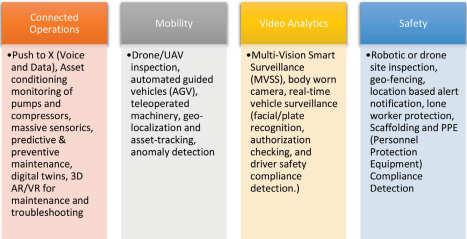
We see 5G-enabled use cases in four main clusters (see Figure 1 above).
There are already existing communication technologies such as Wi-Fi, Bluetooth, LMR/DMR etc. and the devices that partly do not support 5G. Will 5G introduce a new complexity as a new technology?
We at Opticoms see that 5G offers simplicity, by consolidating all existing technologies below 5G. 5G can also retro-fit the already existing non-5G devices using certain integration techniques, so that the alreadymade investments can be utilised. We have delivered many projects where 5G devices and non-5G devices work in hybrid mode
Ali Gencer, chief operating officer, Opticoms.
Ali Gencer, chief operating officer, Opticoms, discusses the benefits of 5G for oil and gas operations.
Communications 34 oilreview.me Issue 1 2023
5G offers simplicity, by consolidating all existing technologies below 5G.”
Image Credit : Opticoms
Image Credit : Opticoms
Figure 1
under 5G. Also, 5G is being used as an umbrella technology to cover the systems such as DMR, LoRaWAN etc.
5G for us is an innovation platform that not only solves today’s challenges such as reliable coverage, high capacity, high bandwidth or 3GPP based advanced security, but also opens up a new world for innovative use cases that will have a direct benefit to the industry.
Are there already deployments of private cellular networks available for the oil and gas industry?
There are several oil and gas companies who have already announced the deployments of private cellular networks. Some examples are listed below:
• Changqing Petrochemical deployed in 2021, the private 5G network enables the intelligent early warning system deployed on the mobile edge computing (MEC) platform which can automatically track the operating status of hundreds of pieces of mobile equipment in the factory area, perform 24-hour uninterrupted real-time calculation and accurate perception, and replace the traditional regular maintenance mode with predictive maintenance. Also, digital twins and advanced visual recognition technologies to establish an intelligent auxiliary inspection route have been enabled using a 5G network and MEC.
• Centrica Storage Limited announced plans in 2020 to deploy a 5G-ready LTE network in County Durham. The target is to enable “new set of maintenance, operations, and safety applications via their handheld devices.”
• Origam Energia deployed a private LTE network in 2022. The deployment covers 13 municipalities in the state of Alagoas, delivering critical network operations to 600 gas production wells, connecting about 800 employees and service
providers. The network will provide highquality voice and video connectivity to site workers, including Push-to-X, with future plans to include telemetry data from wells, providing a video-based AI application to detect unauthorised access to wells in remote locations, worker tracking and health and safety wearables.
What is the expected ROI for the private 5G deployed for oil and gas industry?
Growing adoption of IoT devices is a prime driving factor, creating the need for high-speed, secure and reliable communication technology such as private 5G. ROI for 5G should always be in mind for the initial planning, while each new use case defined later would also impact the ROI positively during the transformation journey. According to Ericsson, there are already use cases listed below which would pay-off the investment for private 5G.
• Reduce unplanned downtime: On average, oil and gas producers experience 32 hours of unplanned downtime every month, costing a single facility US$220,000 an hour and US$84mn annually. By applying asset condition monitoring to pumps and compressors, maintenance sessions can be reduced by 25%, as well as unplanned downtime by 32%. It also extends the life of equipment by 25%.
• Connected safe worker: Using mobile device-accessible schematics and plans combined with features like push-to-video will make workers more efficient both on and offsite. After all, a digitally-enabled workforce is 8.5% more productive and reduces loss from health and safety incidents by 48%. Overall, companies experience an 8% reduction in operational spend due to the increased effectiveness of a digitally enhanced worker.
• Inspection via drones: Conducting
manual site inspections of oil platforms is one of the most hazardous tasks in the industry. High-resolution video drones can easily perform these tasks with much more precision and accuracy and remove humans from potential danger. Drones can reduce inspection times by 90% and downtime costs caused by manual inspections by 65%. Health and safety incidents also decrease, resulting in 35% less cost to the operator.
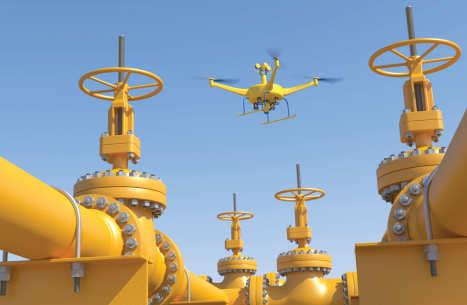
What do you think sets Opticoms apart in terms of your 5G offering; what are your particular strengths?
Opticoms acts as a system integrator, cooperating with a big ecosystem of vendors, device manufacturers, chipset providers and also industry customers, mostly from German industry, to build the solutions that are really needed by the end-user. Our 5G connectivity solution is a flexible, multi-vendor platform that can be adapted based on specific customer needs. To achieve this, we are integrating the connectivity solution with use cases in Opticoms Co-creation Lab using the 100 MHz spectrum granted to us by the German regulator BNetzA.
To what extent do you think oil and gas operators are receptive to 5G technologies, and how do you hope to grow your business in the Middle East and Africa?
The oil and gas industry can significantly benefit from private cellular technology that can save time and money as well as improve safety. According to the estimates from McKinsey & Company, making use of advanced connectivity to optimise drilling and production throughput and improve maintenance and field operations could add up to US$250bn of value to the industry’s upstream operations by 2030.
The potential benefits of advanced connectivity to the oil and gas industry is already visible today, however we see that the benefits indicate only the tip of the iceberg and more is yet to come with advancements in the E2E ecosystem.
As Opticoms, we see great potential in the Middle East and Africa. Until now, we have focused our operations on Europe and gathered experience from several sectors, where we have solved real customer problems together with our partners. We would like to offer our solutions to Middle East and African markets as well, through the establishment of a new hub in Turkey, which would facilitate the logistics and operations. n
We see great potential in the Middle East and Africa.”
Communications Issue 1 2023 oilreview.me 35 Image Credit : Adobe Stock
Drone inspections are among the use cases enabled by 5G.
The time for well intervention
DESPITE GEOPOLITICAL DEVELOPMENTS such as the fresh Covid-19 wave in China and the outbreak of war in eastern Europe, there are a number of positive indications that the stage is set for a prosperous future for the Middle East’s well intervention industry.

This is the position advanced in Offshore Networks’ ‘Middle East Well Intervention Outlook Report’, one of a series of whitepapers analysing the global offshore market’s prospects for 2023 and beyond.
From the explosion of Covid-19 in early 2020 to the autumn of 2022, global uncertainty continued to disrupt the stability of the oil and gas industry and led to wide fluctuations for the oil price. Within this period, prices ranged from as low as US$21.44 per barrel (WTI) to as high as US$122.11 (WTI) before settling at around the US$80 mark at the end of 2022.
As the industry heads deeper into the new year, many commentators are bullish that, partly due to cuts to production by OPEC+, the oil price will stabilise and could even surpass the US$100 mark once again. Morgan Stanley, for instance, has forecasted the Brent oil price to hit as high as US$110. More conservatively, the EIA has suggested the Brent crude oil spot price will average at US$92 for 2023, which is still a healthy figure from the perspective of those working within the industry.
The EIA has also indicated that while oil demand will remain lacklustre in Q1 2023, it will begin to regain meaningful momentum in Q2 2023 and is likely to go beyond 2019 levels in the process. From a longer-term
perspective, OPEC’s 2022 World Oil Outlook 2045 has identified fossil fuels’ continued prominent role within the energy industry for the next two decades and forecasts oil retaining a 29% share in the global energy mix by 2045 with gas holding 24%.
An alternative to drilling
These trends spell happy reading for the oil and gas companies operating within the Middle East and North African region who will have to continue working to increase oil production over the years to meet blossoming demand. However, the environmental concerns have not passed them by, and most operators within the region are also incorporating stringent climate objectives to help mitigate their emissions output.
So how will these organisations balance the tightrope of greater production and less climate impact?
Well, while a number of initiatives are being pursued to help reduce emissions to justify further drilling, one answer lies in well
intervention which offers production rate enhancement without the need for further wells to come online. Indeed, with the oil price looking so healthy, there are expectations that the region’s intervention market will rapidly grow over the short- to medium-term as operators have the cash to explore the option. There are more than 10,000 offshore wells throughout the region (on top of the onshore well count that is much higher), according to Rystad, and these have an average well life of 16-21 years, above the global average of 10-15 years.
Well intervention, which offers the opportunity to revamp the production rates of ageing, flagging wells, is therefore emerging as an attractive solution to tick all boxes.
Read the full report, including an exploration of the factors shaping business objectives from those operating within the well intervention market at:
https://offsnet.com/middle-east-wellintervention-outlook
n
Increased oil demand and a stable oil price are setting the stage for a prosperous future for the Middle East’s well intervention industry.
According to a new report from Offshore Network, prospects for the Middle East’s well intervention market are looking positive.
Well Intervention 36 oilreview.me Issue 1 2023
Well intervention offers production enhancement without the need for further wells to come online.”
Image Credit : Offshore Network

Driving efficiency and sustainability
BRAZIL-HEADQUARTERED WEG, GLOBAL manufacturer of motors and drives, does good business in the Middle East through its operation in the Jebel Ali Free Zone.
“This is a hub for the region; end users here want our support and technical assistance, sometimes looking to upgrade what they have in-house,” says Torrano. “This is where we can improve the efficiency of their systems with products featuring less energy consumption, fewer CO2 emissions and improved processes. This is our goal in the Middle East.”
WEG’s vertical integrated production model, whereby everything from the foundry to the packing stage is made by WEG, means that it can customise products according to customer needs, explains Torrano. WEG Middle East’s focus now is to be a single source of supply solution provider.
“We don’t normally supply directly to the end user, but will try to convince the EPC or end user to use us as a single supplier,” says Torrano. “We have been successful with several framework agreements; we have just got a framework agreement for Borouge 4, part of ADNOC, as a single supplier for motors for one part of the project, and have obtained similar agreements for Duqm refinery in Oman and in the mining sector. Our goal is to be the single supplier of modules, drives and many other electrical components.”
“We can standardise products and improve the efficiencies of the process, since we can provide our own motor and own VFD for any application, whether for a pump, compressor or fan.”
WEG’s vertical integration stood the company in good stead during the pandemic, when many companies were experiencing supply chain difficulties, he adds. While it still required the raw materials, it was able to use these in its own production at its in-house production facilities.
“We have our foundries, and we own a wire plant so we make our own wire, while the enamel for the wire comes from our own chemical plant,” Torrano explains.
Promising opportunities
Torrano sees promising opportunities in the Middle East, particularly in sectors such as fertilisers and gas; the company has a framework agreement with Qatargas for the
North Field expansion.
“What we are seeing is the movement of many OEMS to the Middle East,” he adds. “In the past they had sales offices or service facilities, but more and more assembly and manufacturing is being done locally. The governments are pushing for that, especially in Saudi Arabia but also in Abu Dhabi. We see not only end users here but also manufacturers of equipment. And this may be the way we will need to go ourselves.”
WEG experienced a lot of interest at ADIPEC, he says. The company launched its new variable speed drive (VSD) for the oil and
 Raphael Torrano, managing director, WEG Middle East at ADIPEC.
Raphael Torrano, managing director, WEG Middle East at ADIPEC.
Raphael Torrano, managing director for WEG Middle East, discusses the company’s focus on helping its customers to achieve their efficiency goals.
Motors 38 oilreview.me Issue 1 2023
What we are seeing is the movement of many OEMS to the Middle East.”
Image Credit : Alain Charles Publishing
gas sector, the CFW900, at the show, which boasts increased power density, speed control in industrial applications and can be used to greatly improve efficiency in oil, gas and petrochemical applications. It works with a range of new digital tools from WEG, including Motion Fleet Management (MFM), a control and monitoring tool for the operation of industrial assets including compressors, pumps and fans, using cloud computing and IoT technology, which generates valuable realtime insights on motors, drives and other industrial assets. It allows engineers to make informed decisions about the efficiency and effectiveness of assets – leading to improvements in production processes.
“We are investing a lot in moving from the regular induction motors to the permanent magnet motors, improving efficiency to levels IE5, which is not very common yet in the region,” Torrano says. “We are always innovating and trying to improve efficiencies, investing 2.5% of revenue in R&D every year. That comes at a cost, but we are trying to bring the cost down to benefit everyone.”
More regulation needed
The region would benefit from more regulation in this area, Torrano feels.
“There is a push here from some customers, but it is different from the US, Europe etc., where there is regulation to specify electrical motors to a minimum range of efficiencies,” he says. “Here they can still sell the lowest efficiency motors, and manufacturers often go for the lowest price and don’t care about the efficiency levels. Saudi Arabia was the first to implement the IE3 premium efficiency level.
“Our goal is always to promote higher efficiency motors to customers; there is a higher price premium at the beginning, but payback within two to three years. We have our own software to calculate efficiency levels per kw/hr, and we see it as our role to help users understand the process, and save energy as well.

“This ties in with our logo –‘driving efficiency and sustainability’,” Torrano concludes. n
VEGA Dubai changes name to VEGA Instruments Middle East LLC
VEGA IS AN industry pioneer providing level and pressure instrumentation across various industries. Previously under the French VEGA Technique SAS, VEGA’s Dubai branch has ascended to a standalone sister company based in the UAE, catering to the Middle East and North African regions as of 1 January 2023.

This transition period sees many new phases for VEGA Instruments Middle East, particulary with the continued expansion of its team across the MENA region to ensure reach. With its new claim, Home of Values, the company works towards living and incorporating its values within the organisation and extending the same initiative towards its clients and partners.
The new year is bringing many a change for VEGA’s colleagues and clients alike with much to anticipate and grow towards. Of the many changes to anticipate, the company is keen to expand not just its team but also the offices where there will be a dedicated, state-of-the-art training facility where customers and clients will have the opportunity to gain hands on, face-to-face
immersive training.
Additionally, the resources and inventory will grow to match the region’s demands and operational changes to truly take things in great stride for 2023.
VEGA hopes to continue to cater to its clients and new customers in the MENA
region with the same dedication it has functioned with for the last 15 years in the UAE. With this exciting change, the company hopes to strengthen its ties and firmly plant the values and commitment to the customers across the MENA market under its fresh new business name.
Motors Issue 1 2023 oilreview.me 39
The name change will build upon the expansion of VEGA products and services across the MENA region.
Image Credit : VEGA
The WEG CFW900 VSD.
Image credit: WEG
We are always innovating and trying to improve efficiencies.”
A game changer for fastening on steel
IN THE SHIPBUILDING and oil and gas business segments, high quality welding, bolting, and clamping is sometimes considered an art in itself. Plus, skilled labour is always in high demand and affects the overall cost and delivery of any project. Hilti recognises this as an opportunity for disruption, developing products that can revolutionise fastening on steel. After years of research and development, Hilti is now ready to unveil Cordless Stud Fusion, a system that is nothing less than a game changer for the industry.
To begin with, Cordless Stud Fusion can cover higher loads (up to 11.2 kN) and thinner base materials (2 mm) than previous Hilti products and is up to 95% faster compared to traditional methods such as welding. This fastening method is also safer as it is closer to cold work with almost no splatters or fumes.
A wide range of end-user benefits
For customers running their own businesses or managing operations for a company, Cordless Stud Fusion brings a host of benefits. Compared to welding and other methods like bolting and clamping, Cordless Stud Fusion allows for more speed and flexibility in engineering, procurement and construction. Engineers know they will get reliable loads – through repeatable and consistent fastenings – and therefore peace of mind that you ‘get what you spec’, as well as flexibility for design changes. Procurement can choose from a wide portfolio of studs with international codes and corrosion resistance (up to C5). Construction is not only faster than traditional methods, but it can also be done by almost anyone, with minimal training, reducing the risk of installation error.
All of this gives customers more flexibility and more capacity to finish the work earlier. It’s also a cleaner system with no welding slag, burn marks, ceramic ring waste or postpainting. With the easy-to-follow H-code setting, you get high-quality, consistent, and repeatable fastenings. Plus, with the Active Fusion Indicator (AFI) the installer also gets
systematic real-time feedback to help you to improve the quality of fastening. It is a fully mobile and autonomous system and therefore no mains power or trailing cables are needed. With virtually no sparks, fumes or radiation, and no angle grinder needed for the surface preparation, it also offers significant advantages from a health and safety perspective.
Bogdan Radu Mamina, head of Energy & Industry Region META at Hilti said, “Cordless Stud Fusion is a complete shift in the way the

industry can now approach fastening on steel. Bolting and clamping can be unreliable, and welding is a skill in short supply on most large shipbuilding or oil and gas operations. Business owners as well as operations managers can now rely on Cordless Stud Fusion to save time, effort, and cost while improving quality. A simple and standardised fastener design that can be used for a wide range of applications and virtually no emissions, compared to traditional welding. I believe as time goes by more and more users will see the benefit of this new kind of fastening on steel and it will disrupt the industry in a big way.” n
Visit
for more details, or contact your local account manager.
www.hilti.ae/content/hilti/META/AE/en/business /business/engineering/fastening-on-steel
Hilti’s Cordless Stud Fusion can save time, effort and cost while improving quality.
Hilti outlines the benefits of its newly-launched Cordless Stud Fusion fastening technology.
Innovations 40 oilreview.me Issue 1 2023
Cordless Stud Fusion is a complete shift in the way the industry can now approach fastening on steel.”
Image Credit : Hilti
Optimising lubricants operations with wearable technology
YEHIA EXPLAINED THAT Shell’s desire to continue to support its customers throughout the Covid-19 pandemic was a catalyst for Lube Advisor.
“Here at Shell, we are constantly trying to develop the technologies and innovations to help build a sustainable future, working with our customers, and health and safety is one of the key focuses. That’s one of the reasons why Lube Advisor was born,” said Yehia.
“At the beginning of the pandemic, we wanted to continue to support our customers, while adhering to Covid-19 regulations. Customers operating in remote areas still needed technical support. This wasn’t easy, because of travel and social distancing restrictions. Lube Advisor enables the user to conduct a personalised virtual consultation, directly with our technicians and experts, without a physical site visit, removing the complications of travel arrangements and scheduling. At the same time we can also overcome any restrictions from the safety side.
“Once we have the local technical team connected with our customers, we have Shell Lube Advisor using wearable technology sent to them, which enables real time monitoring of field technicians to ensure their safety, while at the same time providing them with audio-visual assistance to perform maintenance services.”
One of the first adopters of wearable technology, Shell is focused on equipping frontline workers in vital sectors with the technology, that allows them to raise notifications, engage with offsite experts for over the shoulder coaching, communicate for
status of equipment and tools that will ultimately improve safety efficiency and result in faster, better decision making, all in real time. While the oil and gas sector had been the early adopters, its use is now expanding in the construction, manufacturing and transport sectors as well. In terms of geographical footprint, Shell is rolling out the technology throughout the Middle East, in UAE, Qatar, Bahrain and Kuwait.
Yehia commented that even with the easing of Covid-19 restrictions, the technology is becoming increasingly popular given it saves time and energy, contributing to more efficient operations.
Turning to the base oil and lubricants market, Yehia comments that the industrial lubricants market is expected to continue growing, as is the commercial vehicles market. The market for passenger car motor oil, which is more linked to EVs, presents a mixed picture but is growing fast in Europe as well as in India, China and the Middle East.
Yehia stressed that the EV market is an important one for Shell, given its overall vision and strategy to become a net zero emissions energy business by 2050, and to help its customers and society reduce carbon footprint. It has an extensive range of specialised e-fluids and e-greases which target EVs. Shell has also introduced its carbon neutral portfolio, now available for many of its customers in the Middle East, which offers a more sustainable choice for motor oil without compromising performance and engine protection.

Shell is establishing partnerships to extend the reach of its products and their benefits; Shell Markets Middle East signed an agreement with United Motors and Heavy Equipment to be official distributor for its industrial lubricants in Abu Dhabi. This will allow Shell to meet the increasing demand for high quality lubricants and enhance product accessibility for its growing customer base.
“We are working hand-in-hand with customers, helping them not only with direct usage of lubricants but also with reducing total cost of ownership, in areas ranging from storage and handling to disposal and safety,” Yehia added.
“It’s a good step forward, as with this collaboration we can ensure we can reach different types and sizes of customers, and we can offer them technology and support them with more sustainable products,” commented Yehia. “So we can have a bigger impact on society.” n
Shell has launched its Lube Advisor using wearable technology to customers in the Middle East, enabling them to access Shell’s Advisor services remotely in real time to optimise their lubricants operations. Oil Review Middle East spoke to Haytham Yehia, general manager Shell Middle East, to find out more.
Lube Advisor enables the user to conduct a personalised virtual consultation directly with our technicians and experts.”
Wearable Technology Issue 1 2023 oilreview.me 41
Haytham Yehia, general manager Shell Middle East.
Image Credit : Shell Middle East
Supply chains to tighten with clean energy growth: IEA
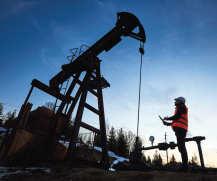

THE ENERGY WORLD is at the dawn of a new industrial age – the age of clean energy technology manufacturing – that is creating major new markets and millions of jobs but also raising new risks, prompting countries across the globe to devise industrial strategies to secure their place in the new global energy economy, according to a major new IEA report.
Energy Technology Perspectives 2023, the latest instalment in one of the IEA’s flagship series, serves as the world’s first global guidebook for the clean technology industries of the future. It provides a comprehensive analysis of global manufacturing of clean energy technologies today – such as solar panels, wind turbines, EV batteries, electrolysers for hydrogen and heat pumps – and their supply chains around the world, as well as mapping out how they are likely to evolve as the clean energy transition advances in the years ahead.
The analysis shows the global market for key mass-manufactured clean energy technologies will be worth around US$650bn a year by 2030 – more than three times today’s level – if countries worldwide fully implement their announced energy and climate pledges. The related clean energy manufacturing jobs would more than double from 6mn today to nearly 14mn by 2030 – and further rapid industrial and employment growth is expected in the following decades as transitions progress.
At the same time, the current supply chains of clean energy technologies present risks in the form of high geographic concentrations of resource mining and processing as well as technology manufacturing. For technologies such as solar panels, wind, EV batteries, electrolysers and heat pumps, the three largest producer countries account for at least 70% of manufacturing capacity for each technology – with China dominant in all of them. Meanwhile, a great
deal of the mining for critical minerals is concentrated in a small number of countries. For example, the Democratic Republic of Congo produces over 70% of the world’s cobalt, and just three countries –Australia, Chile and China – account for more than 90% of global lithium production.
The world is already seeing the risks of tight supply chains, which have pushed up clean energy technology prices in recent years, making countries’ clean energy transitions more difficult and costly. Increasing prices for cobalt, lithium and nickel led to the first ever rise in EV battery prices, which jumped by nearly 10% globally in 2022. The cost of wind turbines outside China has also been rising after years of declines, and similar trends can be seen in solar PV.
New steam flashing technology set to reduce valve erosion
FLASHING CAUSED BY pressurised steam is a destructive phenomenon that occurs in many industries. When controlling steam flow, flashing can take place, and when this happens it can result in severe erosion and damage to the valve components. By reducing flow capacity and eroding the valve itself, flashing is causing unplanned maintenance, reduced reliability, and unacceptable critical safety risks, says Mike Semens-Flanagan, global engineering director at IMI Critical Engineering. With the issue continuing to put pressure on bottom lines in the oil and gas sector, Semens-Flanagan is calling for the adoption of new technologies to help resolve these timely and costly issues.
“For years, plant operators in industries where pressurised steam is used, have struggled with reduced operational performance and diminished valve lifespan as a result of flashing erosion,” explains Semens-Flanagan. “The spiralling maintenance and repair costs that ensue can partially be attributed to the wide-scale adoption of control valves ill-suited to withstand the extreme velocity and pressures over the valve structure.
“To mitigate the safety risks of valve erosion and reduced asset performance, the sector must be open to new and accessible innovations,” he continues. In line with this approach, IMI Critical Engineering has developed EroSolve Flashing solutions to cope with severe flow conditions based on IMI proven technology.”
The component’s angle configuration is designed with hardened trim material, an enhanced seat, and a multi-path, multi-turn plug design to move flashing points away from critical trim parts and, therefore, withstand the most severe conditions. Its globe configuration option, on the other hand, utilises a seat basket to reduce downstream velocity and avoid damage to the valve body, without having to modify the existing pipe configuration.
The effectiveness of EroSolve Flashing has already been well demonstrated, for example in a combined cycle power plant that experienced
erosion issues in the Heat Recovery Steam Generators (HRSG). Engineering analysis defined the root cause to be high-velocity vapour and low-velocity flow fluids, creating a high degree of flashing conditions. With EroSolve Flashing installed in May 2021, the replacement component experienced no damage when inspected after a year of operating.
“Resolving safety concerns while maximising asset production efficiency, is a key priority across the oil and gas sector,” Semens-Flanagan concludes. “This is especially the case for valves in applications facing extreme velocity, pressures, and severe flashing. EroSolve Flashing has been configured to effectively overcome these difficulties and create significant savings in terms of lifecycle costs and valve maintenance.
“When accompanied by the maintenance and servicing experience of expert personnel, such as our own Valve Doctors®, valve lifecycles can be extended by up to four times compared to similar products. At a time where all sectors and specifiers are under pressure to reduce capital expenditure and operating costs, selecting these solutions allow organisations to do more with less,” he said.
For more information, visit: https://www.imicritical.com/aftermarket/valve-upgrades/erosolveflashing/
Innovations
The global market for key massmanufactured clean energy technologies will be worth around US$650bn a year by 2030.
42 oilreview.me Issue 1 2023
Resolving safety concerns while maximising asset production efficiency is a key priority.
Image Credit: Adobe Stock
Image Credit: Adobe Stock
New manufacturing hub
EMERSON HAS BROKEN ground for a state-of-the-art innovation and manufacturing hub at the King Salman Energy Park (SPARK) in Saudi Arabia, further expanding its local capabilities. The facility will be one of the largest investments in the Middle East and Africa region for the company.

The facility, which is slated to open by December 2024, will provide industrial customers in the region with services for control systems engineering, staging and testing, manufacturing of differential pressure (DP) transmitters and control valves, pressure relief valve assembly and solenoid valve assembly.
The project demonstrates Emerson's continued commitment to its customers and stakeholders in Saudi Arabia as the company prepares for rapid local manufacturing expansion in the region. The new facility will be developed in accordance with environmental sustainability principles to support the company’s net zero emission goals, while also adhering to SPARK's environmental sustainability standards.
New AI seismic interpretation software launched
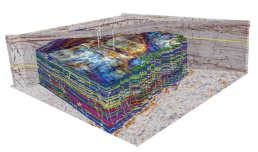
GLOBAL ARTIFICIAL INTELLIGENCE (AI) seismic interpretation experts Geoteric have launched Geoteric 2023.1, which will enable operators to de-risk well placement, reduce their environmental impact and increase profitability by better predicting future production.
Emerson’s construction of an innovation and manufacturing hub at SPARK aligns with Saudi Arabia's 'Saudi Vision 2030,' a strategic framework to promote local content and improve localisation.
“Our state-of-the-art innovation and manufacturing facility at King Salman Energy Park propels our expansion strategies in the Middle East and Africa region,” said Lal Karsanbhai, Emerson’s president and chief executive officer. “This investment represents a significant milestone in our mission to provide quality and reliable services for our customers in Saudi Arabia.”
Emerson is pursuing value chain localisation as part of the ‘Made in KSA’ initiative and has targeted supply chain localisation opportunities across its various products in collaboration with local suppliers.
Building on Geoteric’s cutting-edge AI fault interpretation that accurately detects faults invisible to the human eye, the new release now includes structurally-aware AI Horizons. The technology identifies every event from surface to region of interest in hours, and comes at a crucial time for operators facing demands to fast-track production. The software will enable 100% interpretation of the data in a seismic volume, even in complex geology, in a very short time frame, enabling assets to be brought online safer and faster.
The technology identifies every event from surface to region of interest in hours.
“Customers will be able to complete projects faster than ever before with no compromise on accuracy or quality,” said Nicola Blanshard, CEO, Geoteric. “Whether they need to understand compartmentalisation of their reservoir for better production prediction, de-risk future well placement or be able to quickly identify suitable and safe locations for carbon capture and storage (CCS) sites."
Weatherford teams up with DataRobot
WEATHERFORD HAS SIGNED a multi-year agreement with DataRobot, a leader in artificial intelligence (AI), to deliver advanced AI solutions in its digital platforms, including the ForeSite production optimisation and Centro well construction platforms. Through this new relationship with DataRobot, Weatherford will accelerate the development of machine learning (ML) and AI-enabled offerings within its Digital Solutions portfolio to deliver disruptive and innovative technologies to the market. Providing an integrated solution combining physics-based and AI models at scale enables understanding and leveraging of large quantities of data from every corner of an asset to improve operations performance.
Matt Foder, senior vice president of Innovation and New Energy at Weatherford, commented, “We began our Industry 4.0 journey in 2017 by introducing our first AI/ML-based modules in our software platforms. This agreement with DataRobot adds a solid foundation to operationalise and scale these modules and those of our customers, providing incremental value across the energy industry space. This collaborative innovation is aligned with our promise of delivering open and flexible digital platforms to our users.”
Collaboration to reduce methane emissions
ENVIRONMENTAL INTELLIGENCE
COMPANY Kayrros will supply the United Nations Environment Programme (UNEP) with data for its International Methane Emissions Observatory initiative, designed to dramatically reduce the concentration of methane in the atmosphere.
Kayrros will contribute to advance UNEP’s goal of building a science-based global dataset of empirically-verified methane emissions at an increasing level of accuracy and granularity. The data will help companies and national regulators reduce methane emissions.
Kayrros and UNEP's IMEO will collaborate with leading scientists to push the capabilities of satellite monitoring and provide new insights to support climate action through methane mitigation in the framework of the Methane Alert and Response System (MARS). MARS is the first publicly available global system capable of transparently connecting methane detection to notification processes.
The data supplied by the Kayrros Methane Watch platform will allow for increasingly detailed analysis of reported methane emissions from oil, gas and coal (both thermal and metallurgical) extraction around the world.
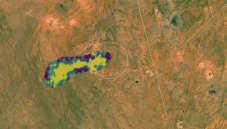
Innovations
The groundbreaking ceremony.
Issue 1 2023 oilreview.me 43
The data supplied by Kayrros will allow for increasingly detailed analysis of methane emissions.
Image credit: Emerson
Image credit: Geoteric Image caredit: Kayrros
Project Databank
Compiled by Data Media Systems
OIL, GAS AND PETROCHEMICAL PROJECTS, EGYPT
Project Name City Facility Budget (US$) Status ANOPC - Hydrocracking Diesel Complex - Hydrocracker Complex Asyut Hydrocracker 2,800,000,000 Construction EGAS - GASCO - Dahshour Gas Compression Expansion - Train 5, 6, 7, 10A Dahshur Gas Compression 156,000,000 Construction RSNRPC - Ain Sokhna Petrochemical Complex Ain Soukhna Polyethylene, Polyester 7,500,000,000 FEED AGIBA - South West Meleiha Development Lease Western Desert Development Drilling & 269,000,000 Construction Production Apex International Energy - South East Meleiha - Concession Exploration Western Desert Development Drilling & 100,000,000 Construction Production Petro Shorouk - Zohr Gas Field Development Mediterranean Sea Offshore Gas Field 15,600,000,000 Construction Energean - North El Amriya-North Idku Development - Subsea Tie-Back Idku Gas Field 235,000,000 Engineering & Procurement GASCO - Western Desert Gas Complex - Train D Western Desert Gas Field 100,000,000 Construction RSNRPC - Polypropylene (PP) Plant Suez Canal Polypropylene 1,700,000,000 Feasibility Study Economic Zone (SCZone) SMD - Formaldehyde and Derivatives Plant Damietta Melamine, Methanol, 41,000,000 Construction Sulphuric Acid, Formaldehyde, Urea Kuwait Energy Egypt - Abu Sennan Concession - Infill Project Western Desert Development Drilling & 100,000,000 Construction Production SDX Energy - West Garib Concession - Rabul Field Gharib Development Drilling & 58,000,000 Feasibility Study Production SIDPEC - Propane Dehydration (PDH) Plant Alexandria Propylene 730,000,000 Feasibility Study ECHEM - El Alamein Petrochemical and Refinery Complex New Alamein City Butadiene, Benzene 8,000,000,000 Feasibility Study ECHEM - SCZone Refinery & Petrochemicals Complex - Overview Suez Canal Refining 7,500,000,000 FEED Economic Zone (SCZone) PETROBEL - Nooros Exploration Prospect (Abu Madi West) Nile Delta Offshore Gas Field 12,000,000,000 Construction NOSPCO - Offshore North Sinai Concession - Phase 3 - North Sinai Gas Field 95,000,000 Pre-FEED Kamose and Tao Field Development ECHEM - SCZone Refinery & Petrochemicals Complex - Suez Canal Butadiene 3,200,000,000 Feasibility Study Petrochemicals Complex Economic Zone (SCZone) Total - OLA Energy Egypt - Mex Petroleum Zone - Phase 1 - Alexandria Refining 200,000,000 FEED Alexandria Petroleum Products Terminal (APPT) Eni - North El Hammad License - Bashrush Discovery Nile Delta Gas Field 200,000,000 Feasibility Study Eni - Nour Gas Field Exploration North Sinai Gas Field 100,000,000 Feasibility Study SUCO - Disouq Concession - Phase 2 - Field Development Disouq Development Drilling & 100,000,000 FEED Production EGAS - Tina to Mit Nama Loop Gas Pipeline Various Gas Pipeline 150,000,000 Engineering & Procurement Agiba - Western Desert Gas Processing Plant Western Desert Gas Processing 700,000,000 Construction
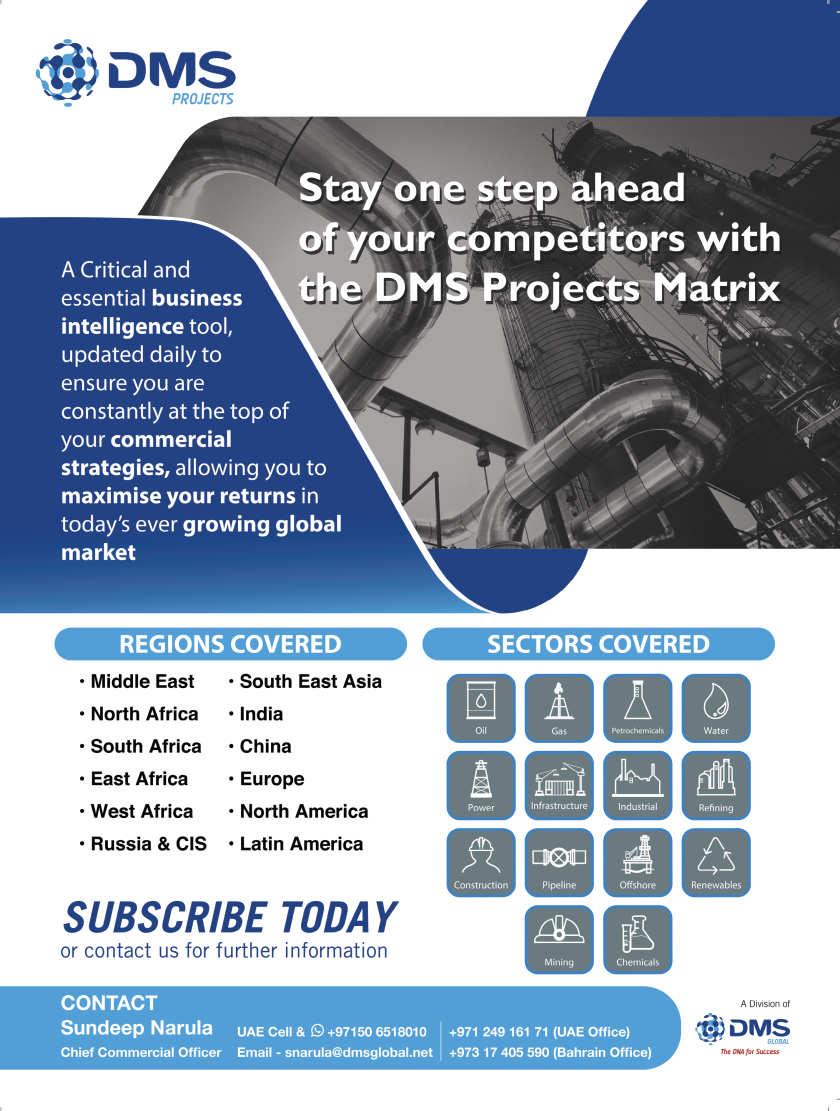
Project Databank
Compiled by Data Media Systems
Project Focus
Compiled by Data Media Systems
ANOPC - Hydrocracking Diesel Complex - Hydrocracker Complex
Name of Client ANOPC - Assiut National Oil Processing Co.
Estimated Budget (US$) 2,800,000,000
Contract Value (US$) 2,200,000,000
Award Date 2015-Q3
Main Contractor TechnipFMC
Facility Type Hydrocracker Status Construction Location Asyut, Egypt
Project Start 2014-Q3
End Date 2024-Q4
Background
Assiut National Oil Processing Co. (ANOPC), a subsidiary of Egyptian General Petroleum Corp.'s Assiut Oil Refining Co. (ASORC), aims to maximise diesel production to satisfy the growing local demand from petroleum products in Assiut, the southern area of Egypt. The complex will transform lower-value petroleum products from Assiut Oil Refining Company's nearby refinery into approximately 2.8mn tons per year of cleaner products, such as Euro 5 diesel.
Project Scope
The scope of project involves maximising diesel production, introducing the most modern refinery technologies to satisfy the growing local demand from petroleum products. It includes engineering, procurement, construction (EPC), pre-commissioning, commissioning, and start-up tests for the following:
• Vacuum distillation unit (VDU)
• Distillate hydrotreating unit (DHU)
• Sulfur recovery unit (SRU)
• Sulfur solidification unit (SSU)
• Civil work
• Transportation
• Erection
• Mechanical works
Alongside Euro 5-quality diesel, the project will produce the following:
• 360,000-400,000 tpy of naphtha
• 91,000-101,000 tpy of LPG
• 331,000 tpy of coke
• 57,000-66,400 tpy of sulfur.
Middle East & North Africa

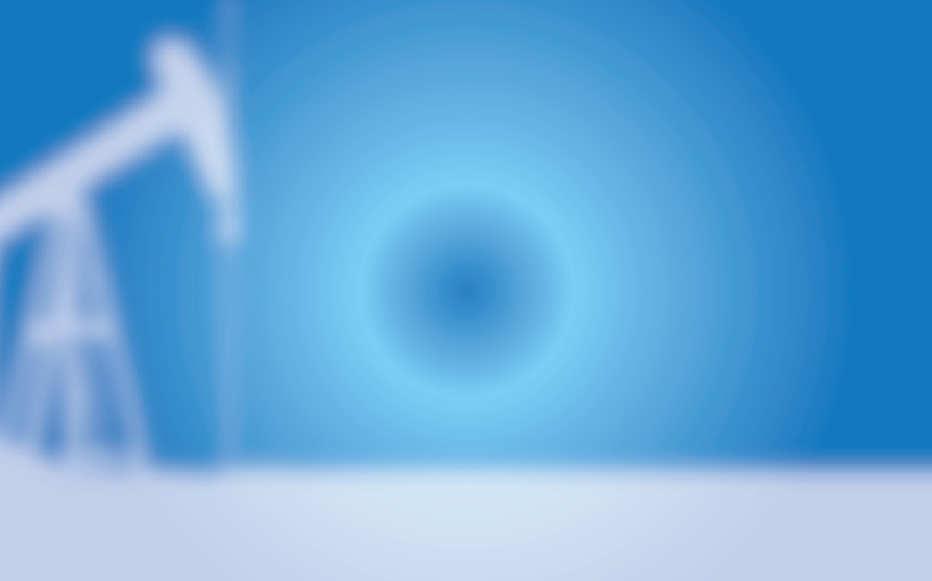











The Baker Hughes Rig Count tracks industry-wide rigs engaged in drilling and related operations, which include drilling, logging, cementing, coring, well testing, waiting on weather, running casing and blowout preventer (BOP) testing.



North Africa













RIG COUNT Issue 1 2023 oilreview.me 47
Source: Baker Hughes
DECEMBER 2022 VARIANCE NOVEMBER 2022 Country Land OffShore Total From Last Month Land OffShore Total Middle East ABU DHABI 36 15 51 +1 35 15 50 DUBAI 0 1 1 0 0 1 1 IRAQ 55 0 55 0 55 0 55 JORDAN 0 0 0 0 0 0 0 KUWAIT 26 0 26 -3 28 1 29 OMAN 49 0 49 0 51 0 51 PAKISTAN 11 0 11 -1 12 0 12 QATAR 4 7 11 -3 5 9 14 SAUDI ARABIA 64 16 80 -1 64 16 80 SUDAN 2 0 2 0 2 0 2 SYRIA 0 0 0 0 0 0 0 YEMEN 1 0 1 -1 2 0 2 TOTAL 248 39 287 -7 252 42 294
ALGERIA 34 0 34 +2 32 0 32 EGYPT 25 8 33 +1 27 5 32 LIBYA 9 0 9 +1 8 0 8 TUNISIA 2 0 2 0 2 0 2 TOTAL 70 8 78 +4 69 5 74
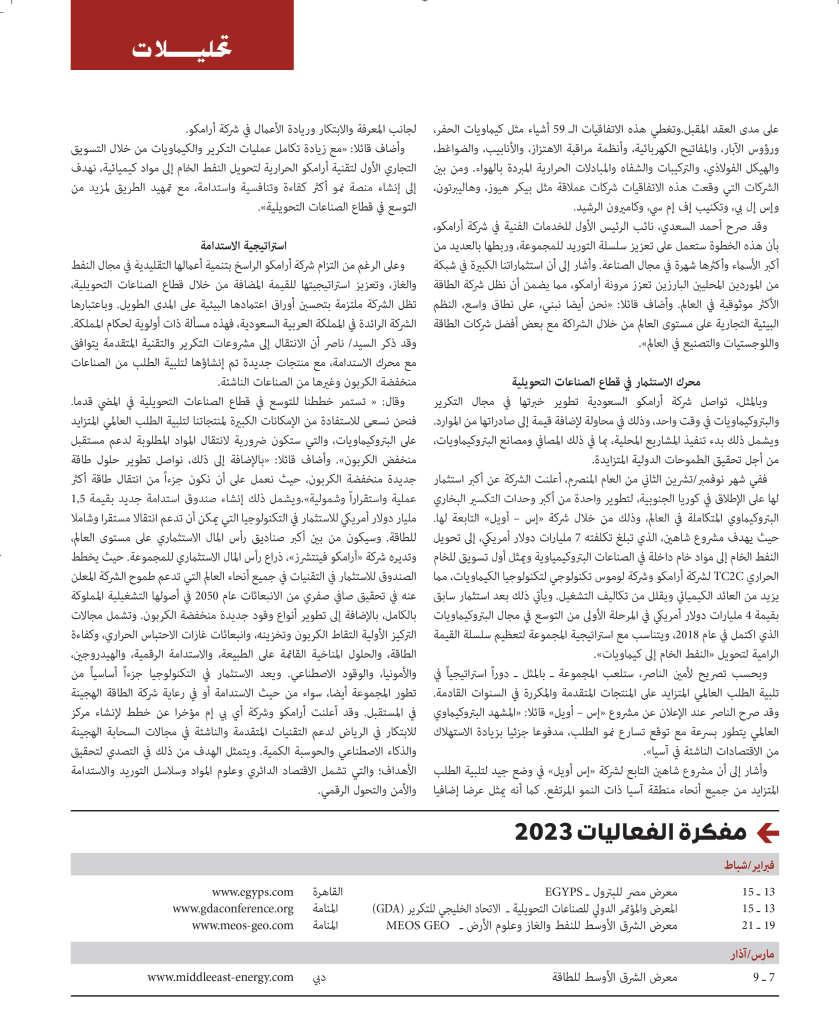
05 oilreview.me Issue 1 2023
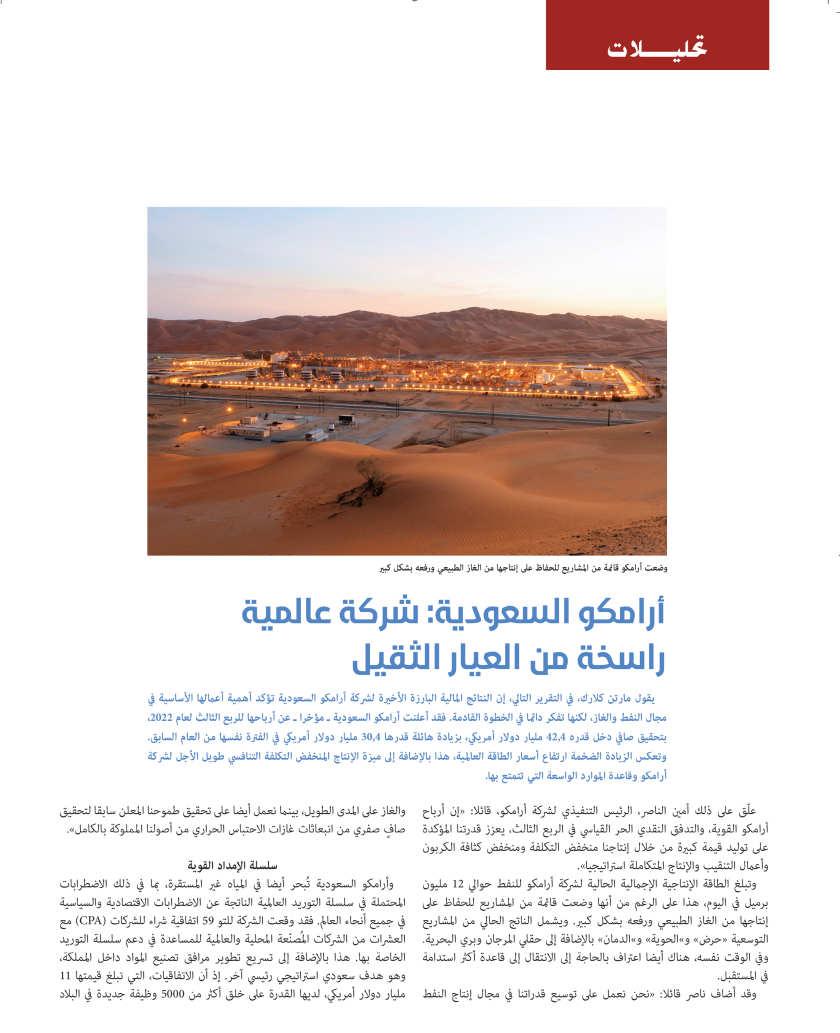
Issue 1 2023 oilreview.me 04

Company......................................................................................................................................................................Page DMS Global WLL...........................................................................................................................................................................................................................................45 DownUnder GeoSolutions............................................................................................................................................................................................................................7 Euro Gas Systems S.R.L.................................................................................................................................................................................................................17 & 25 Helmerich & Payne, Inc.............................................................................................................................................................................................................................13 Informa Markets (MEOS/GEO 2023).....................................................................................................................................................................................................23 Informa Middle East Limited (Dubai Branch) MEE 2023...............................................................................................................................................................11 MABI AG...........................................................................................................................................................................................................................................................19 Oman Cement Company..............................................................................................................................................................................................................................2 Triplefast Middle East Ltd............................................................................................................................................................................................................................5 WEG International Trade GmbH..............................................................................................................................................................................................................21 ADVERTISERS INDEX





















































 Raphael Torrano, managing director, WEG Middle East at ADIPEC.
Raphael Torrano, managing director, WEG Middle East at ADIPEC.










































